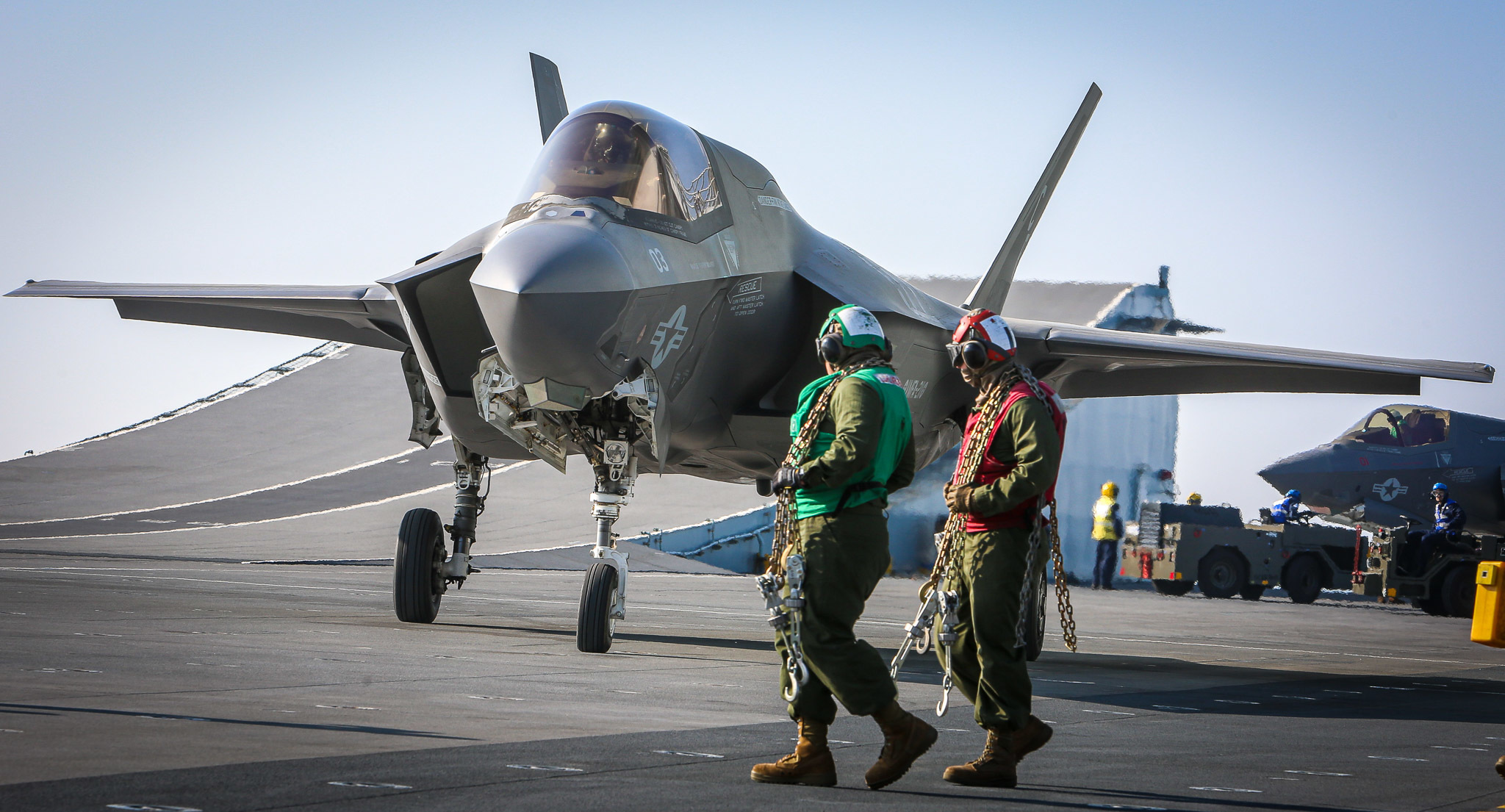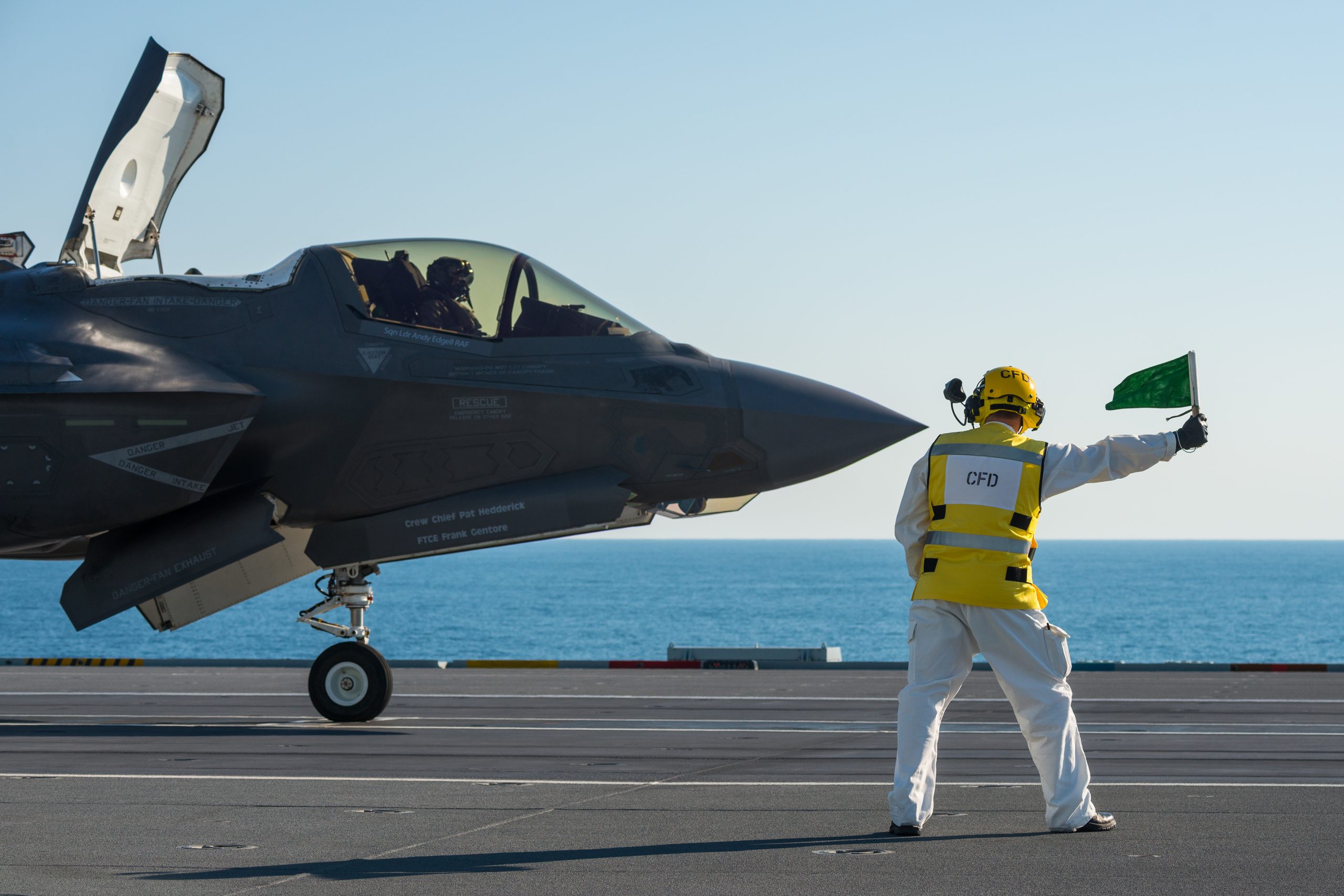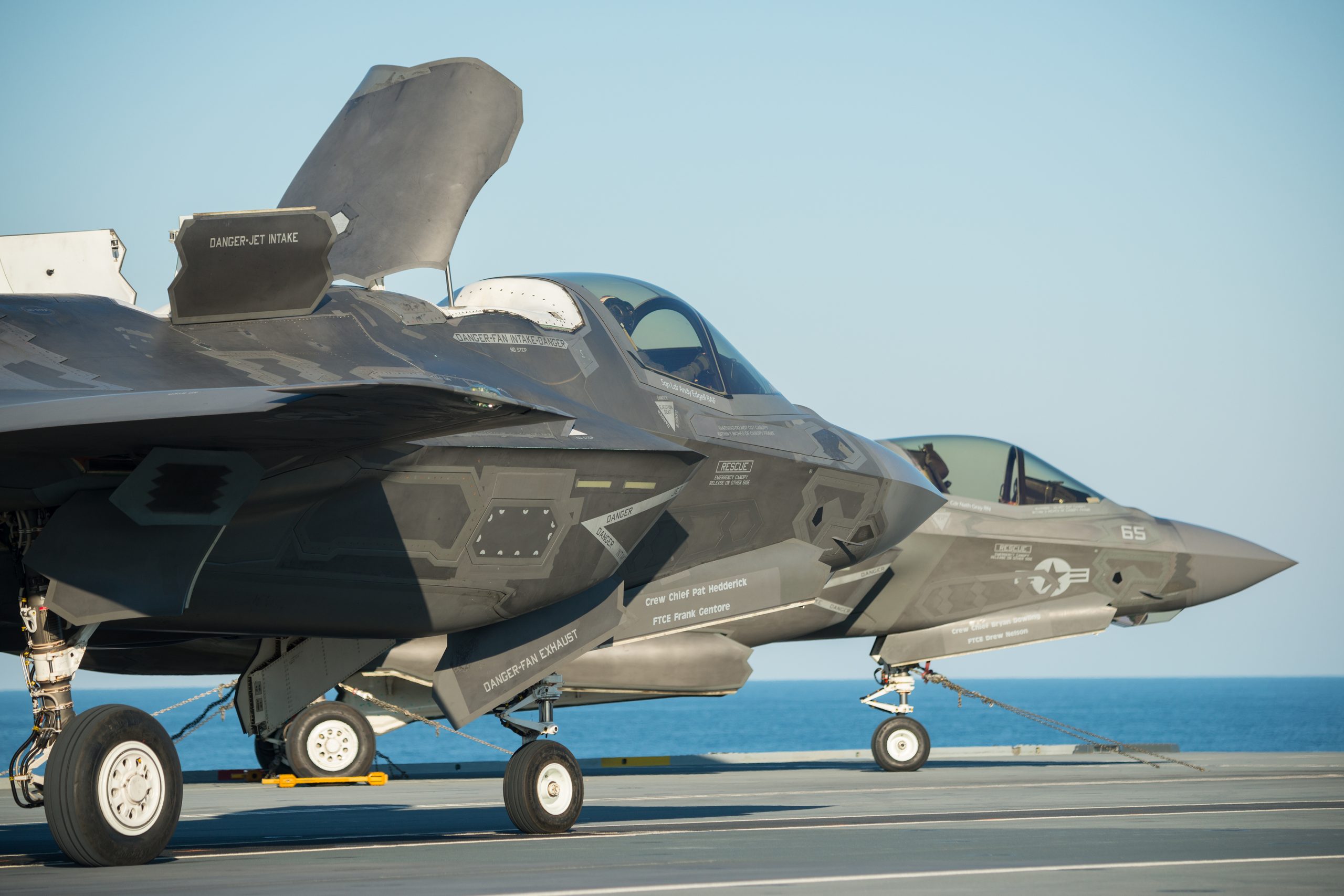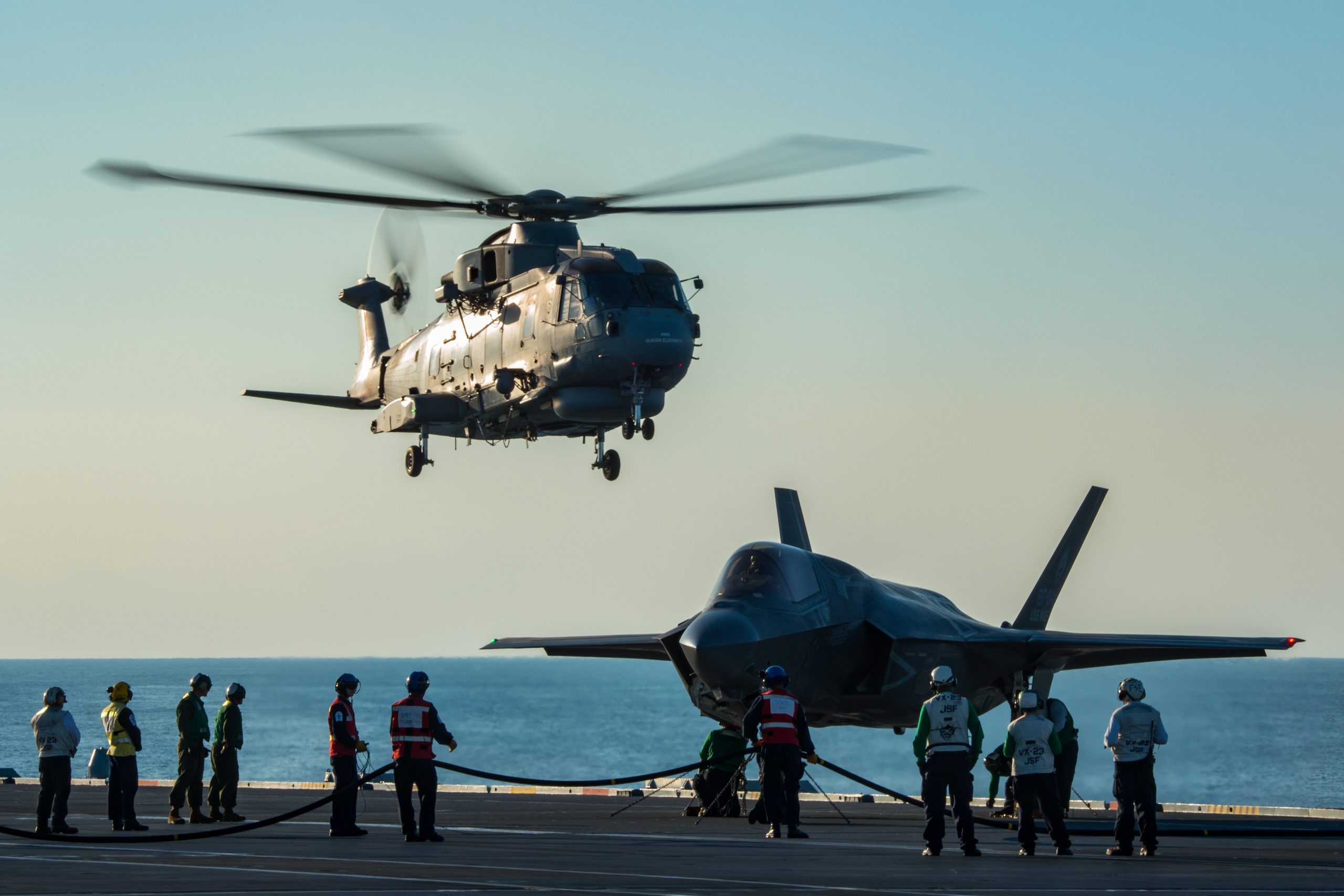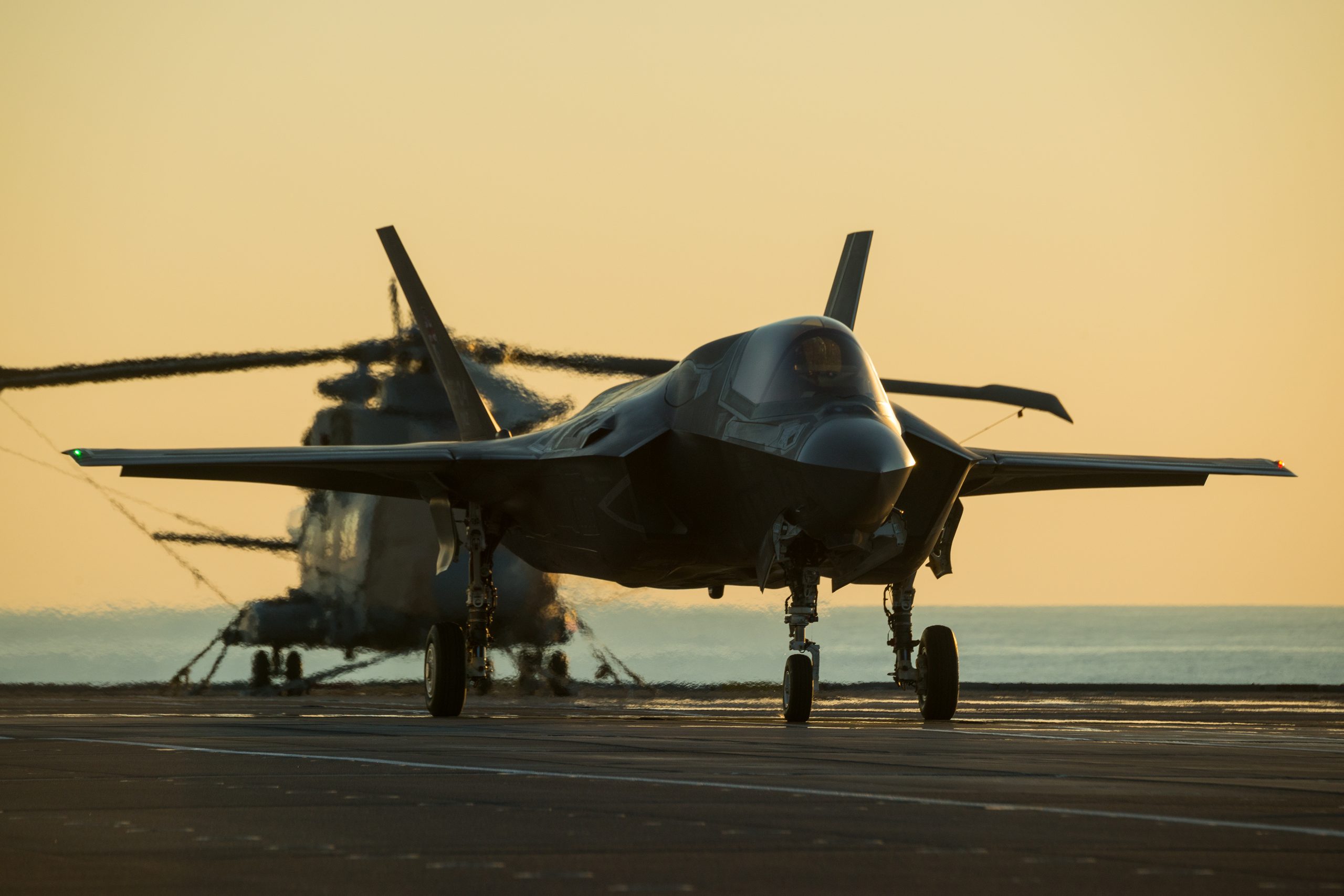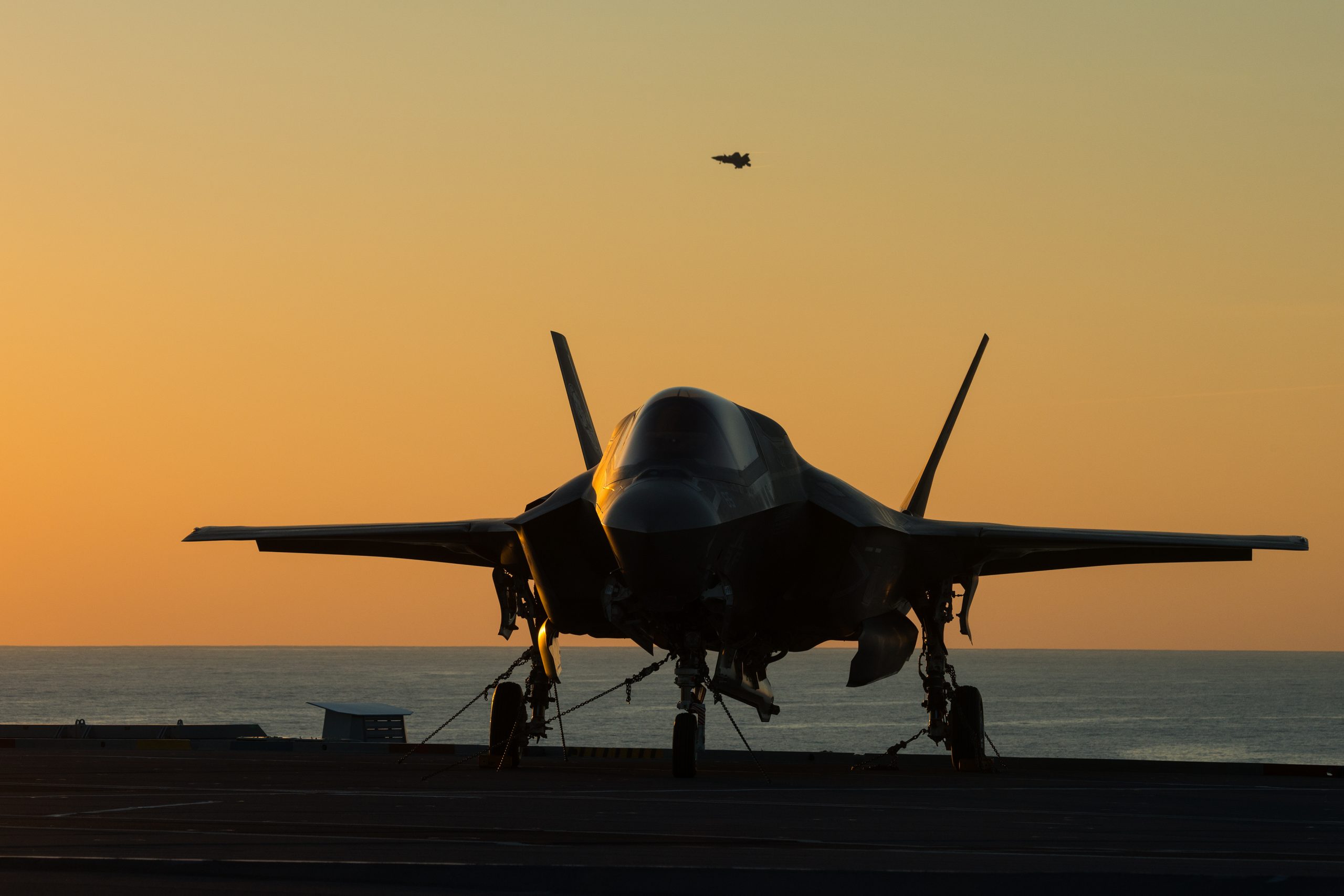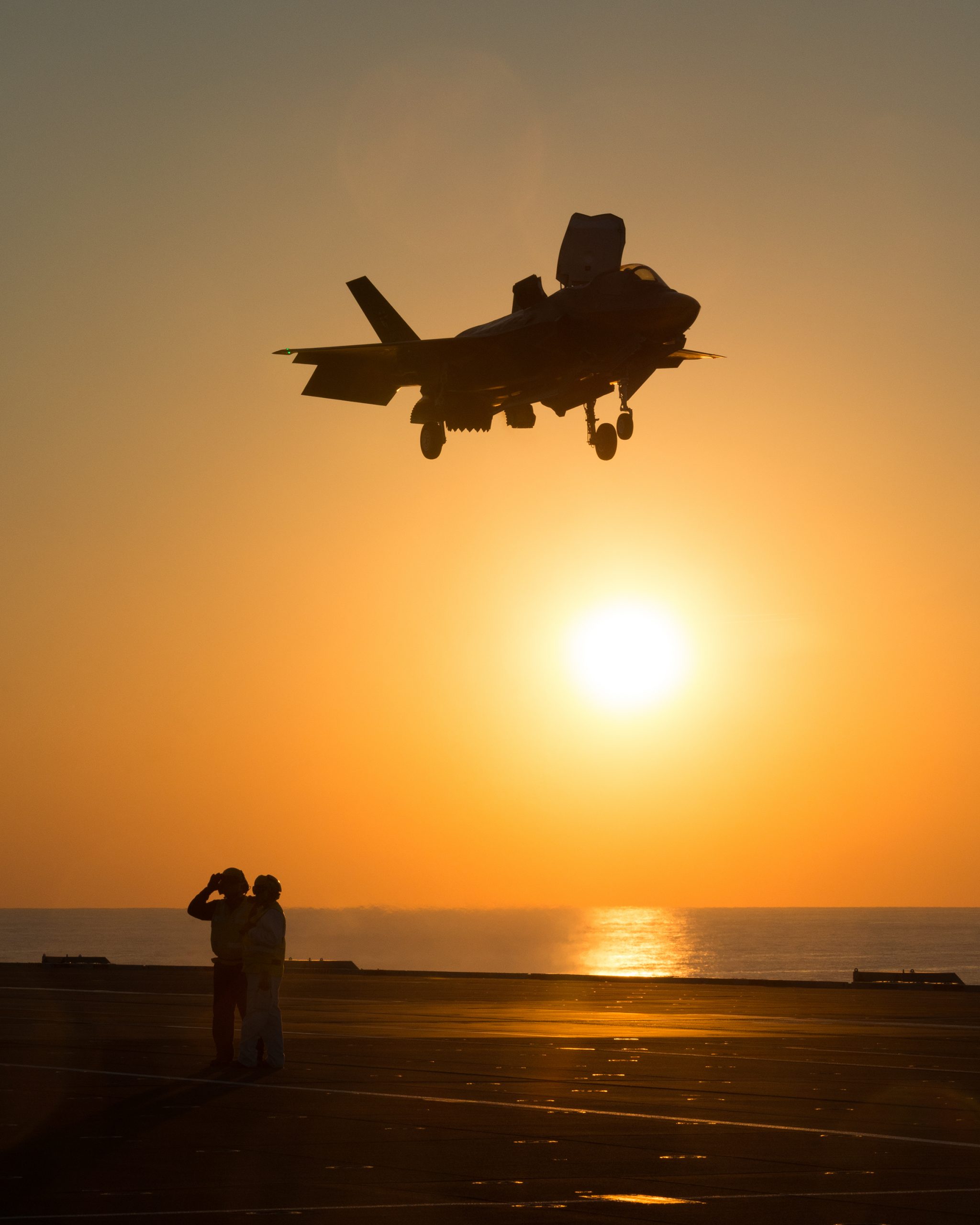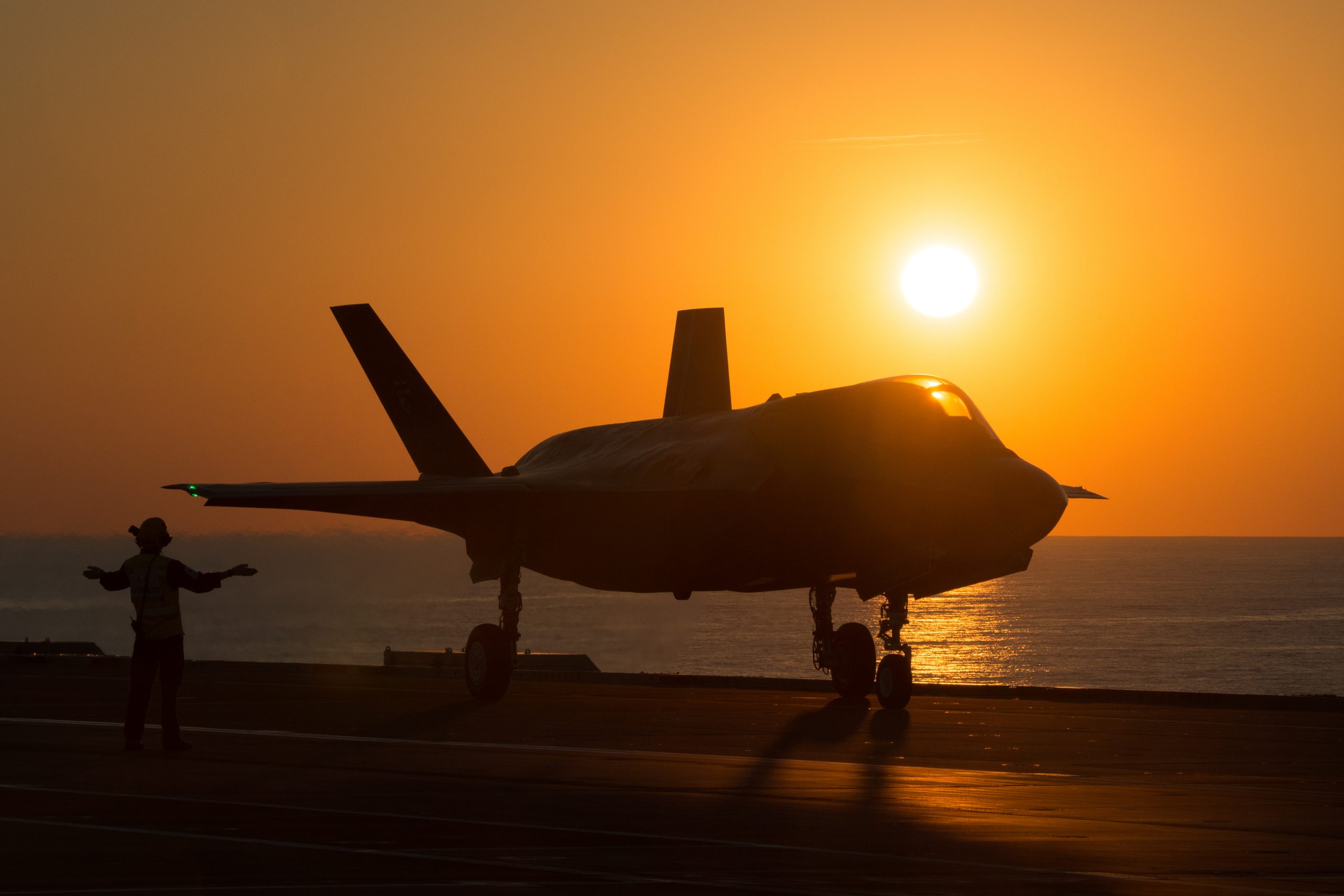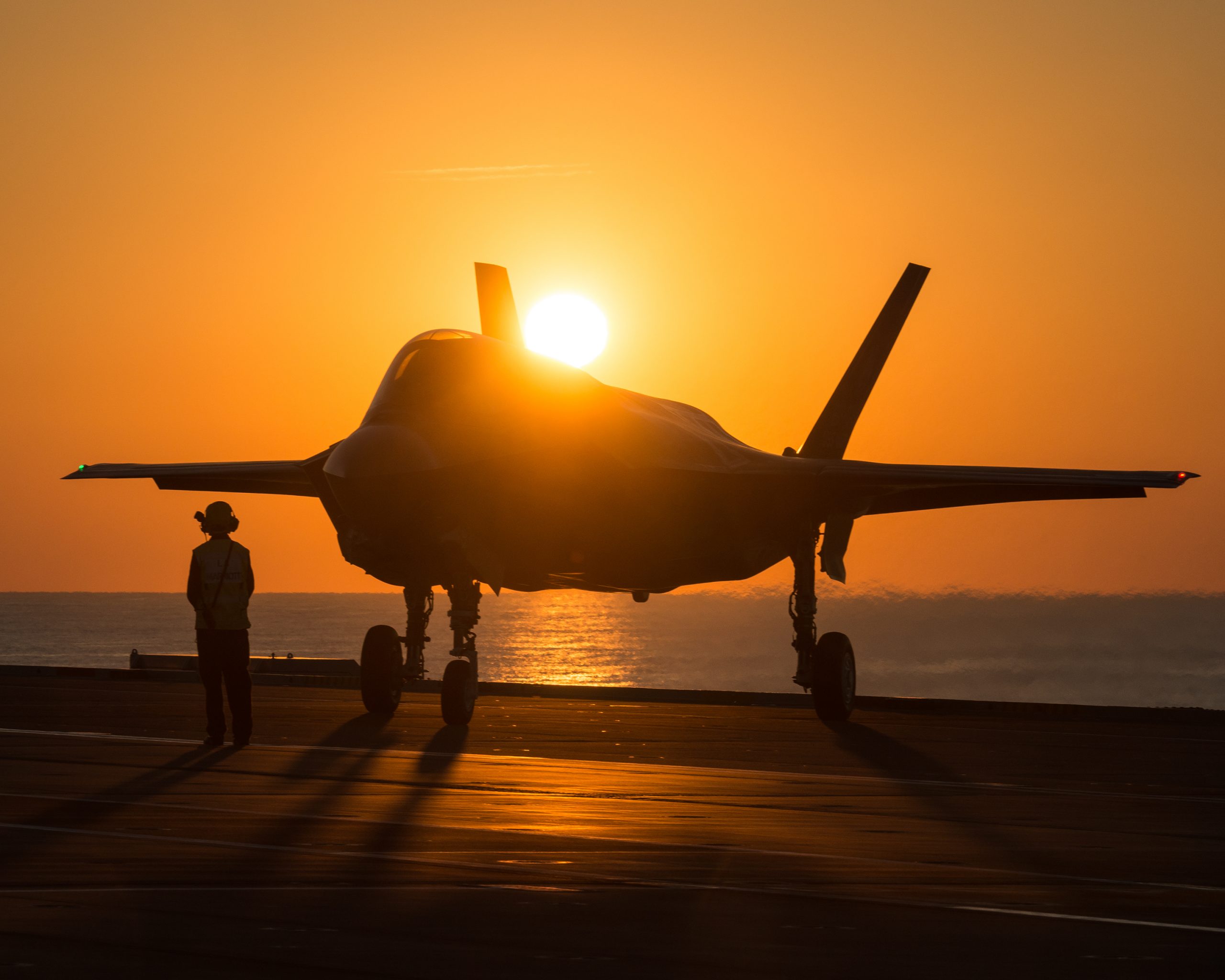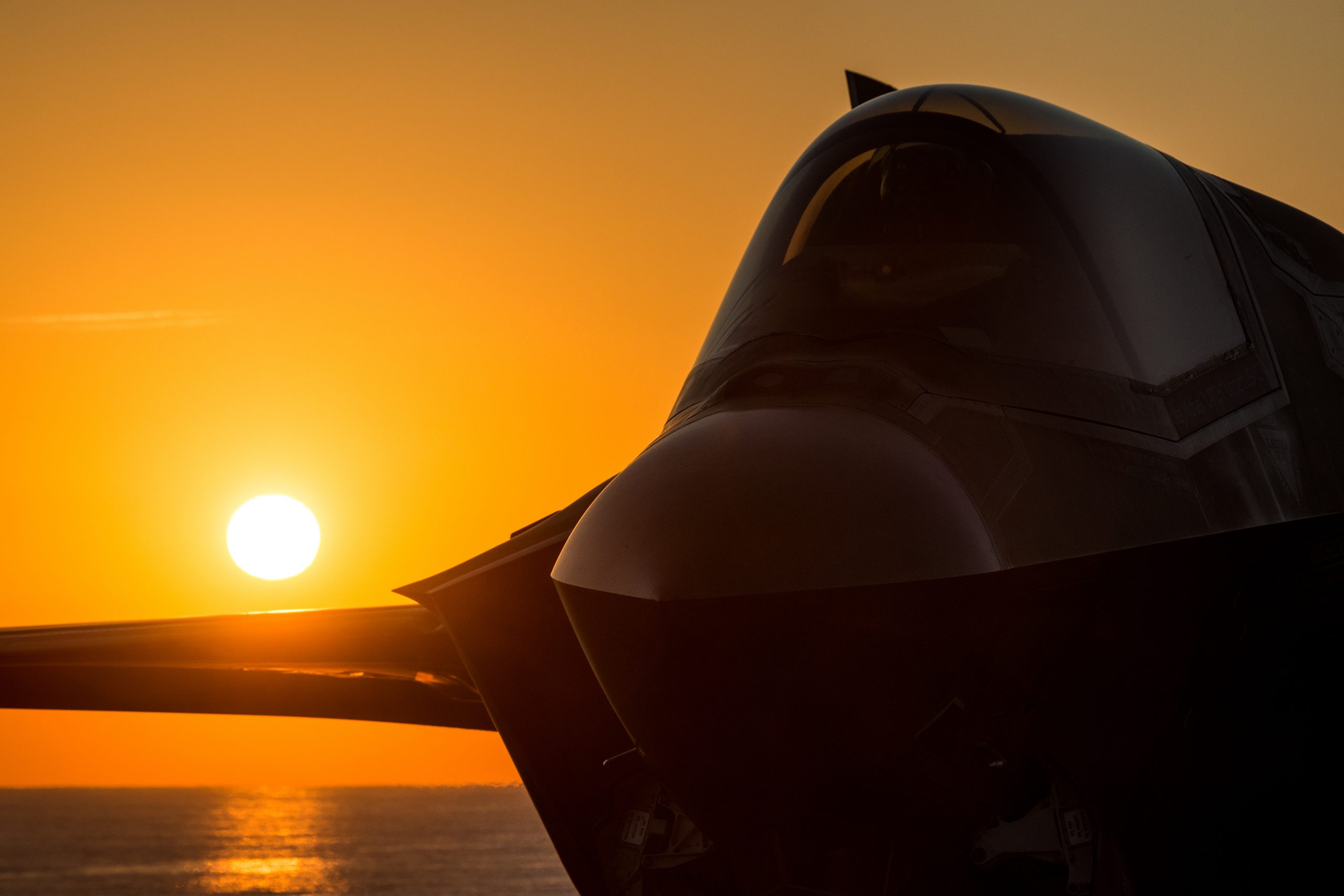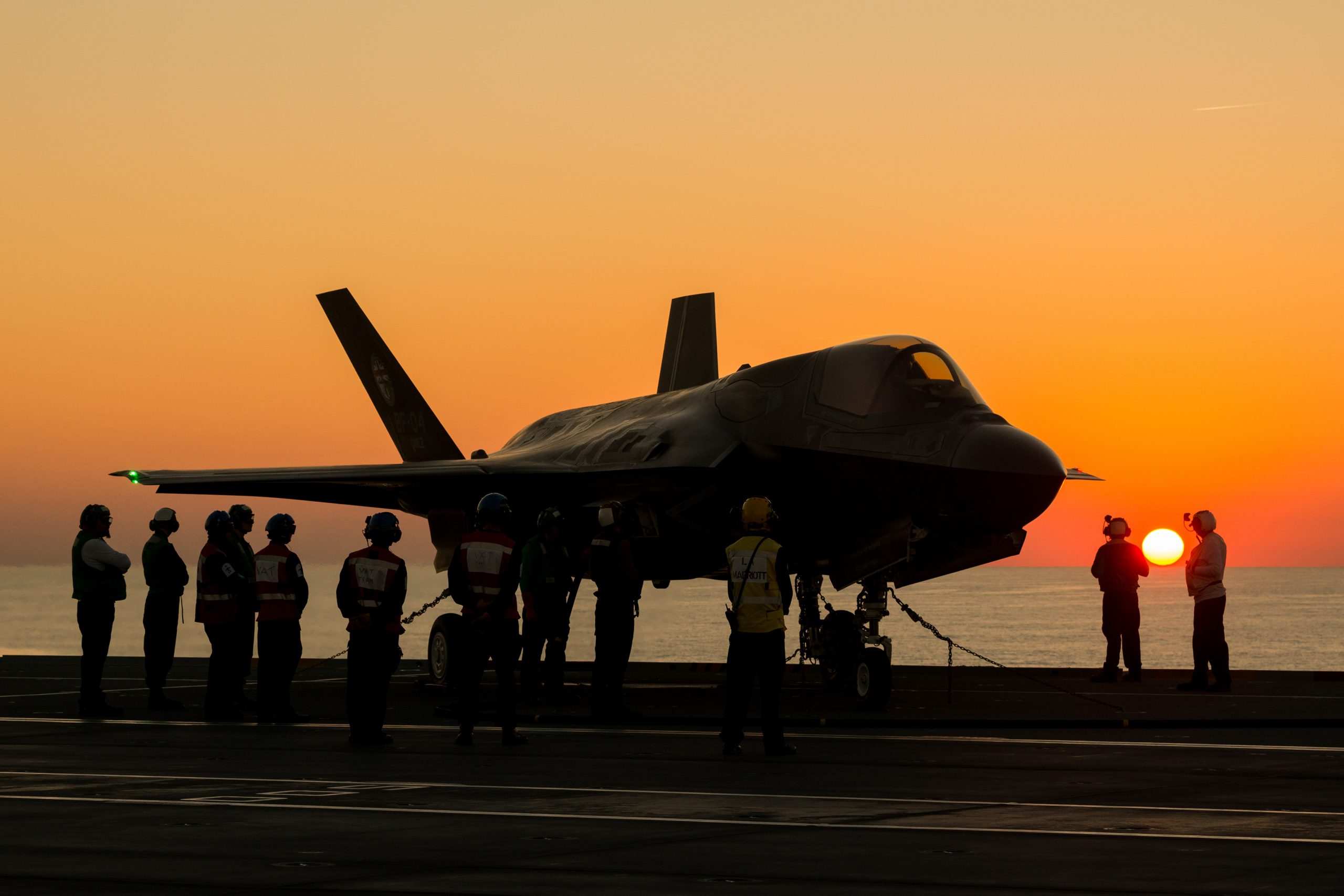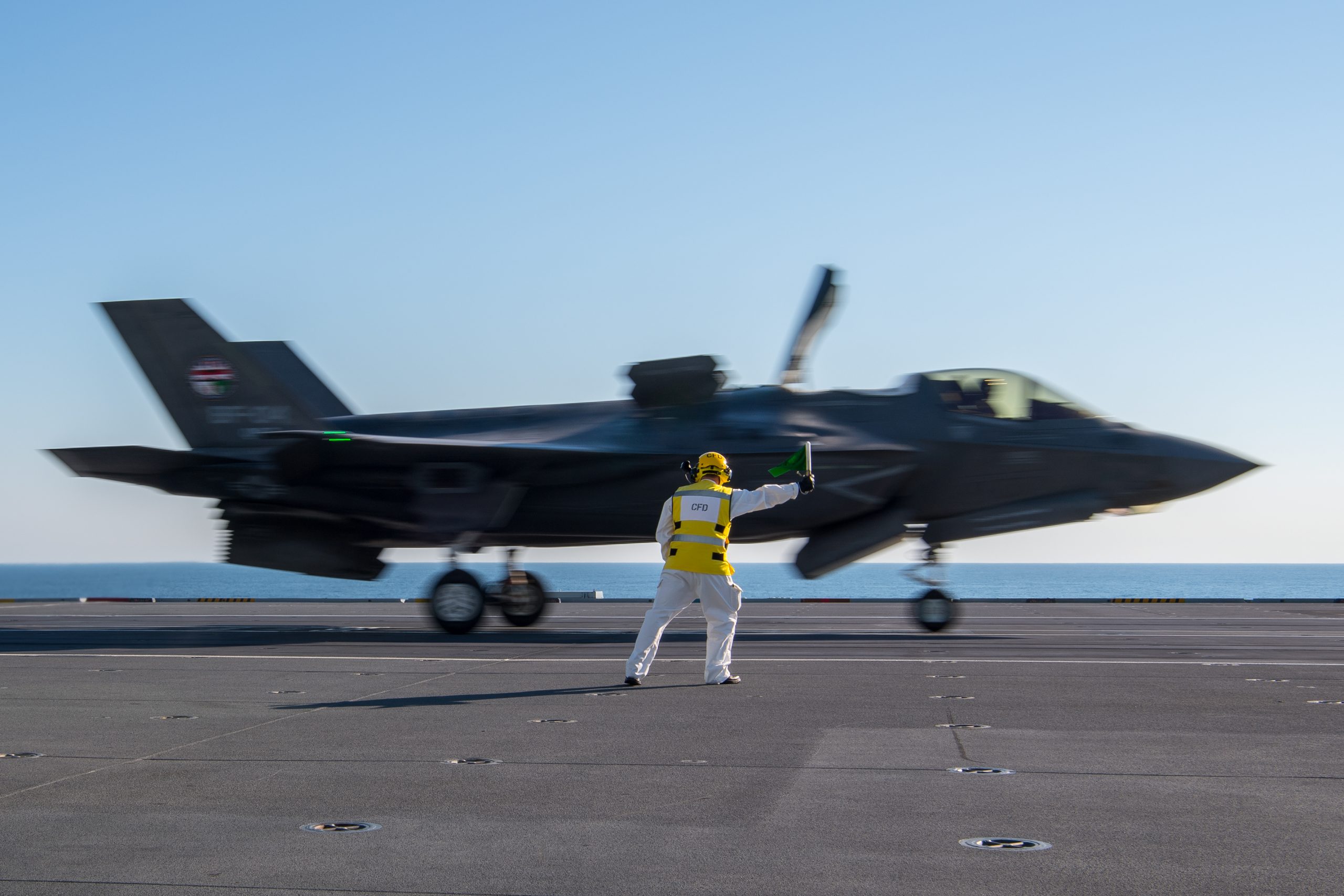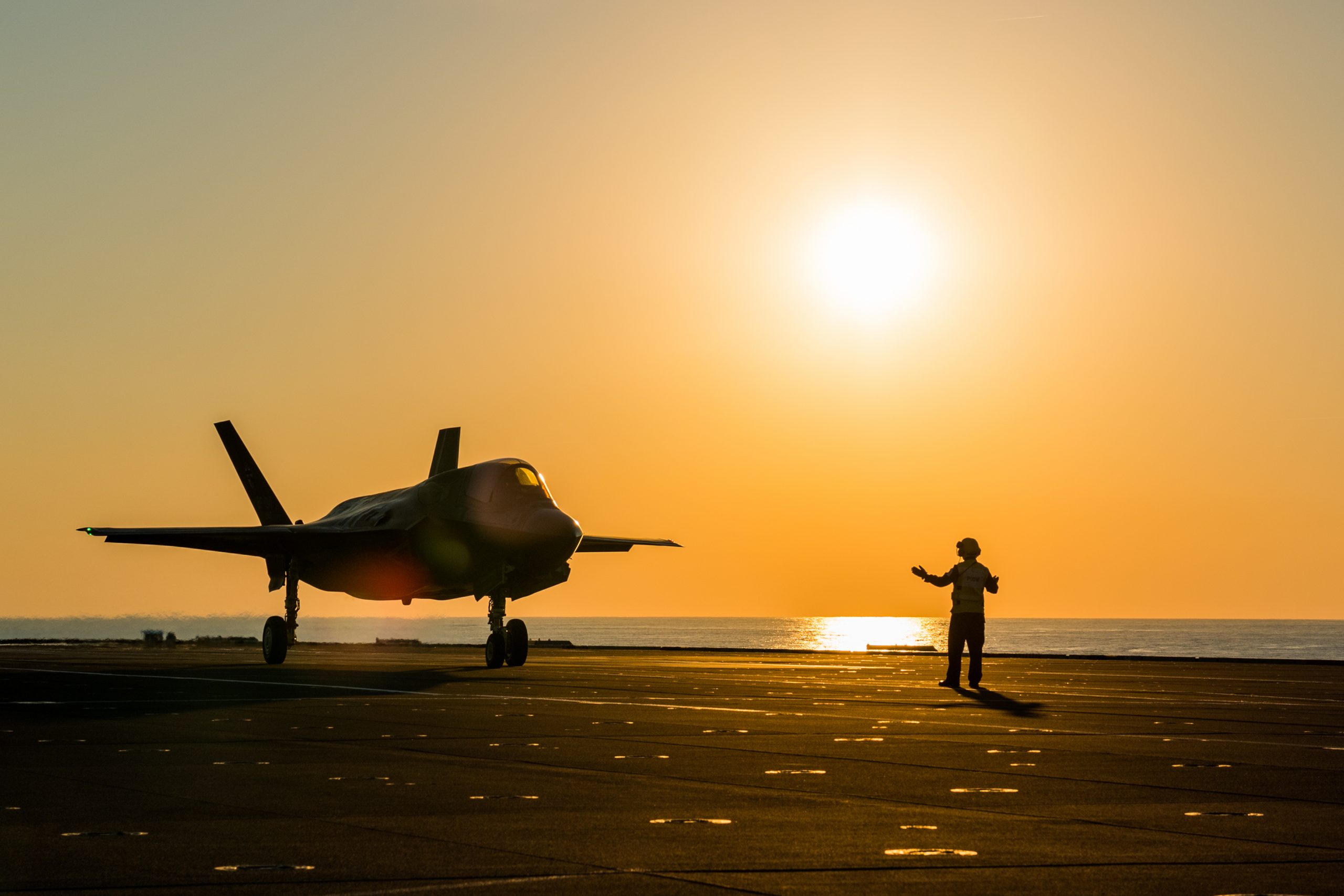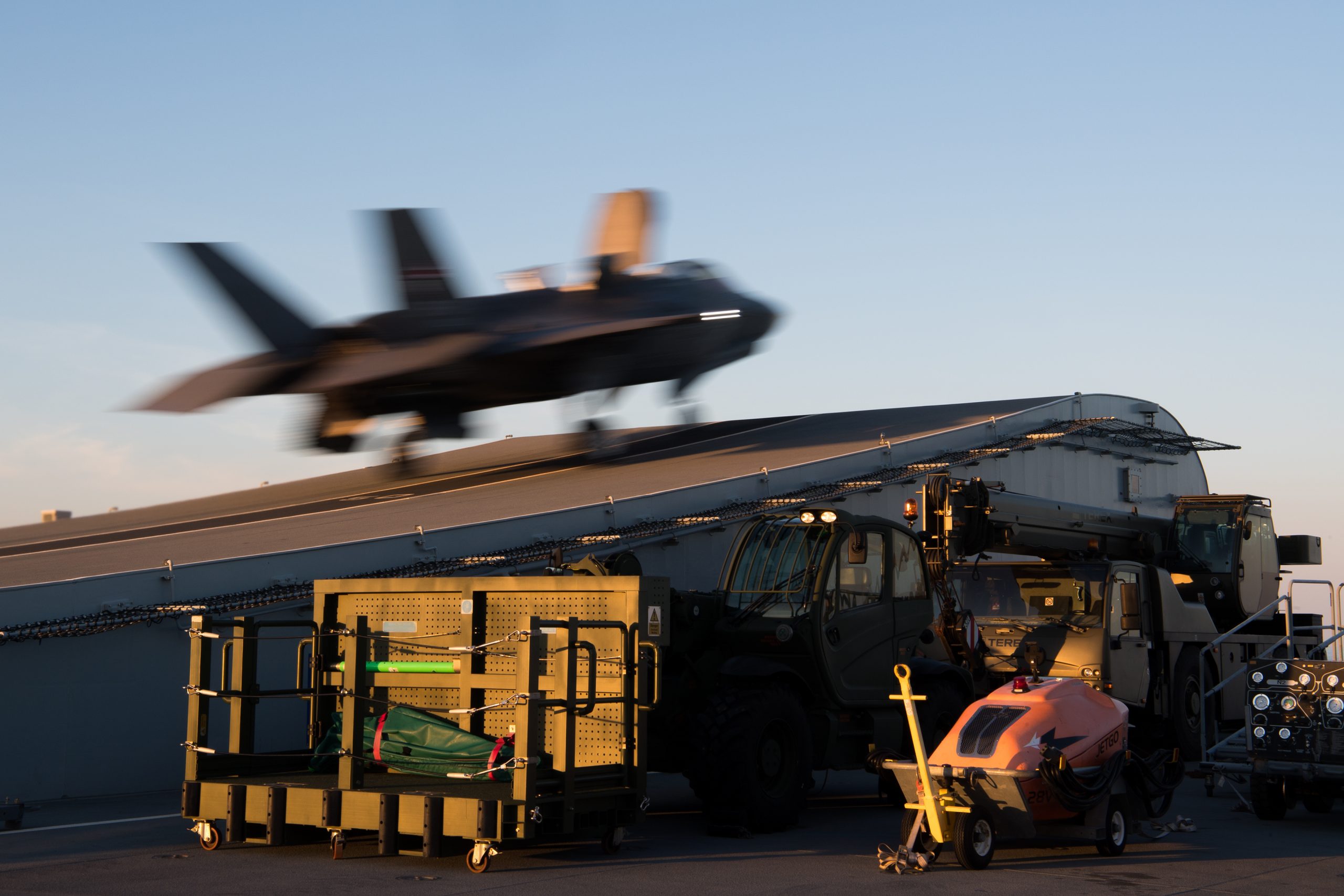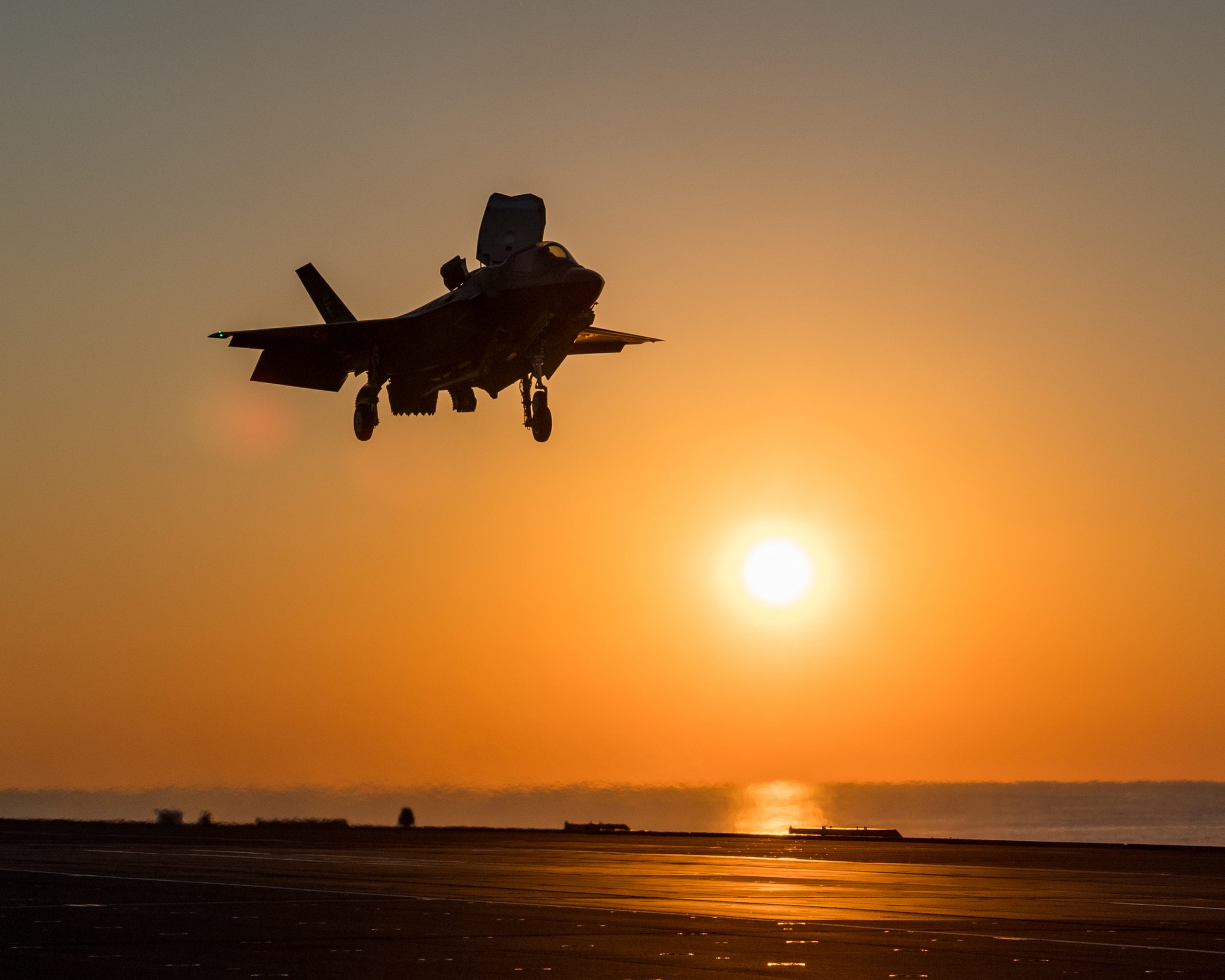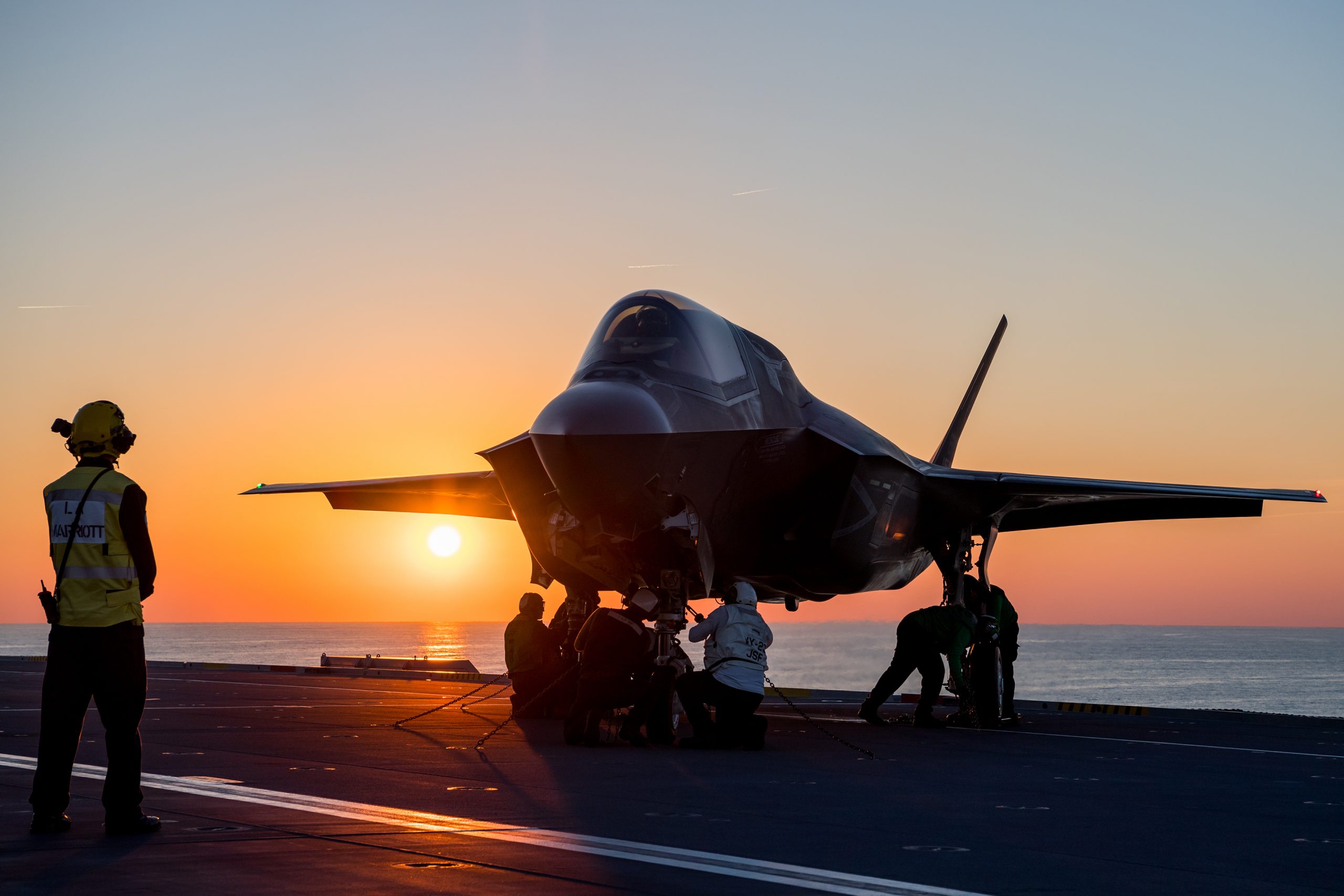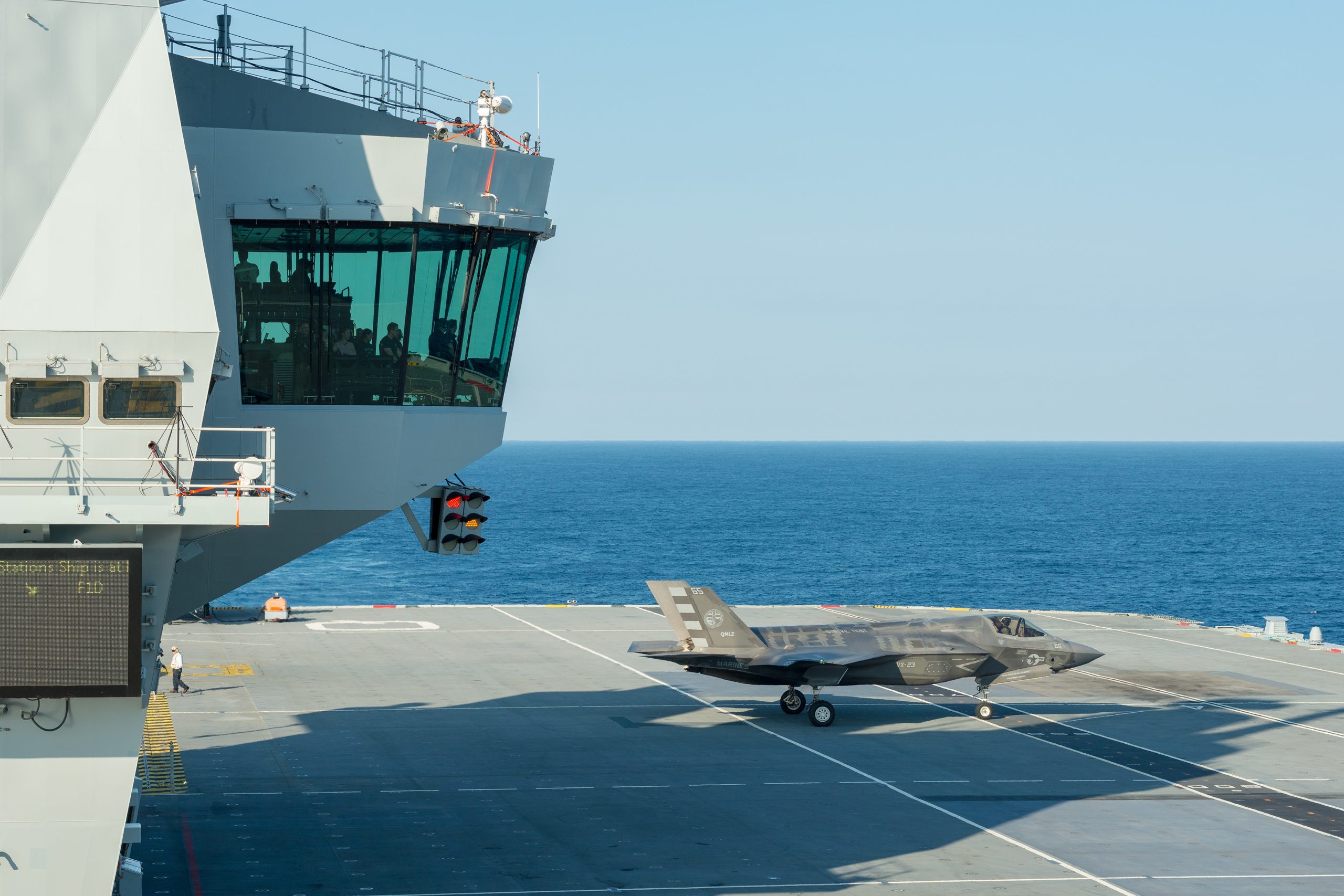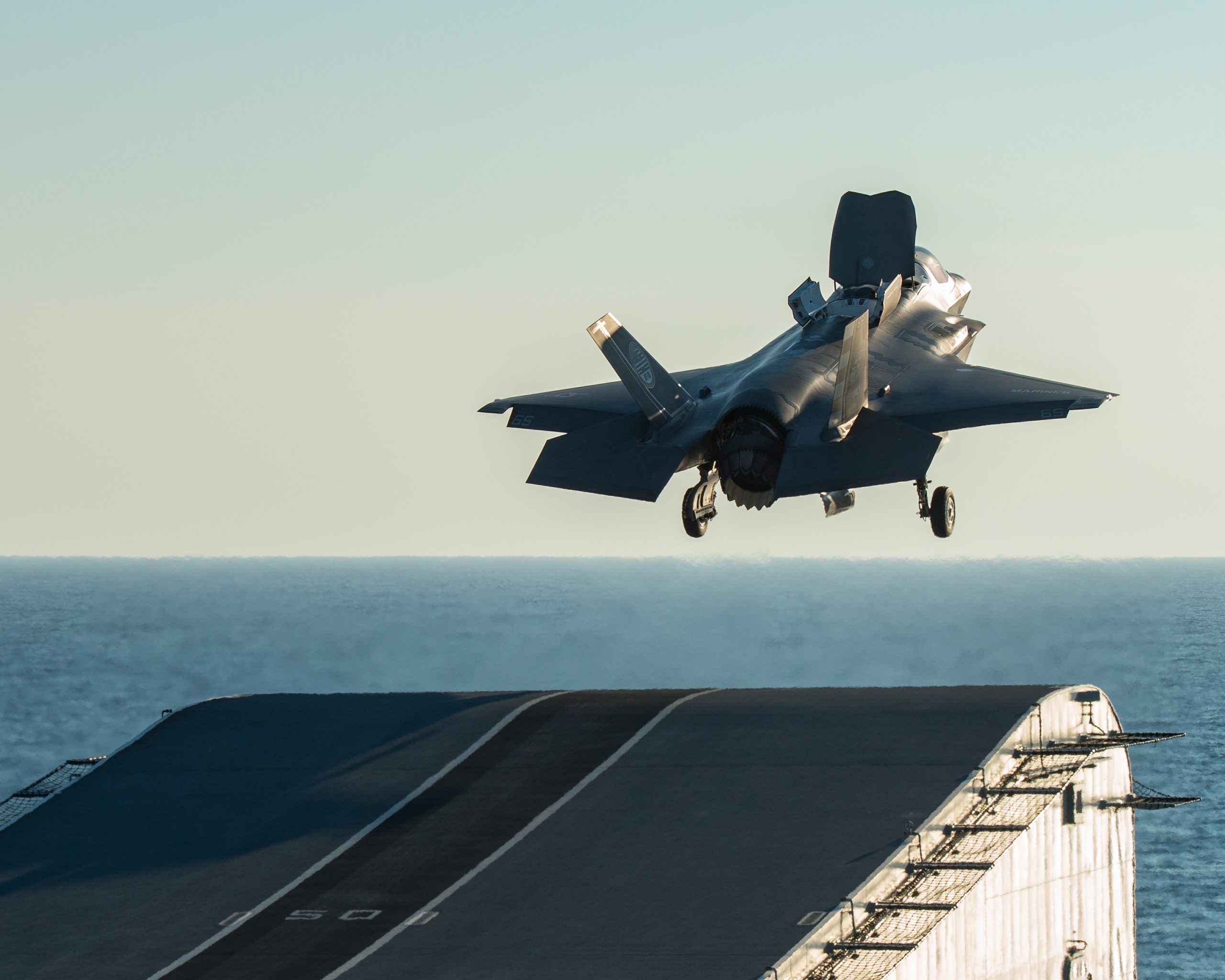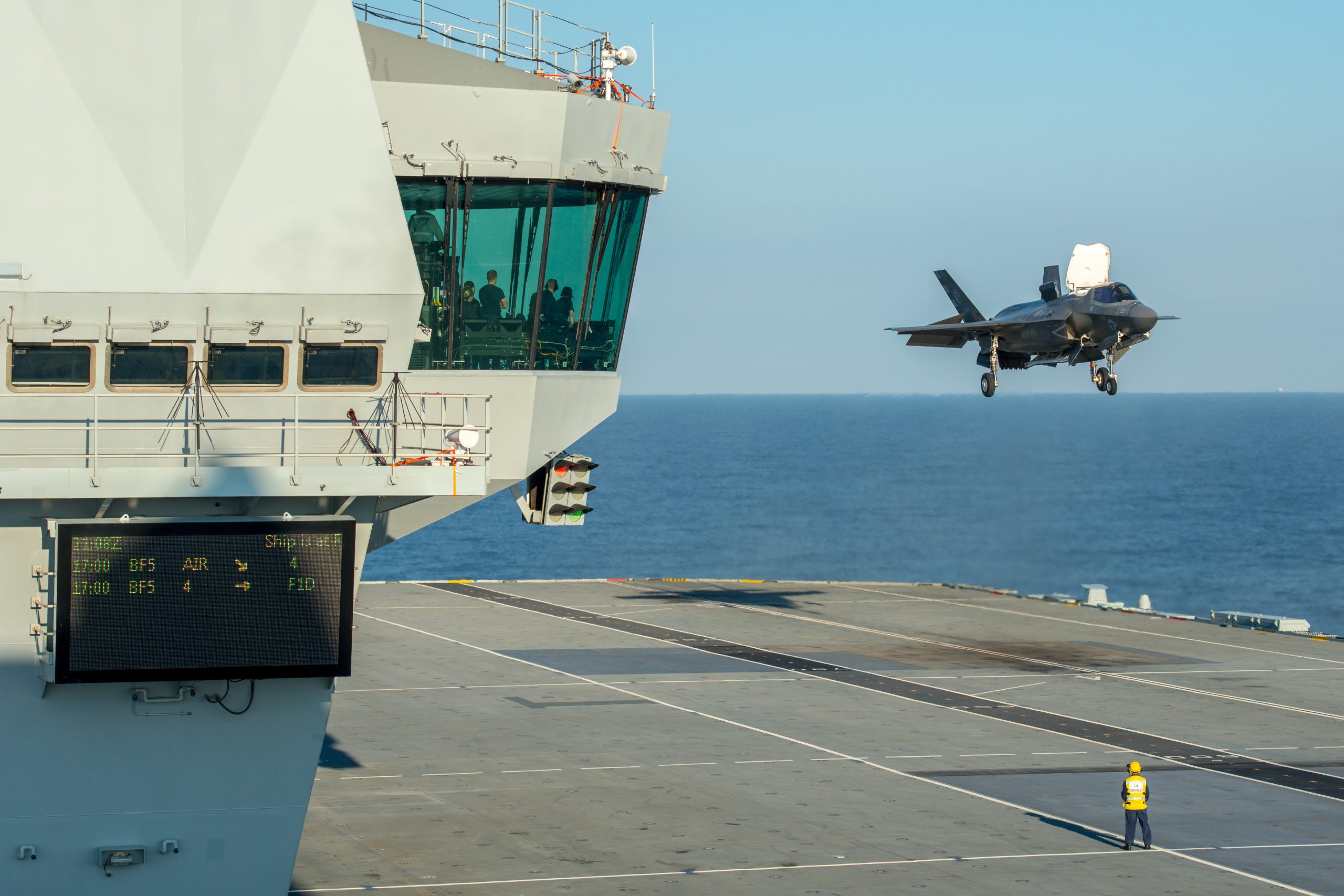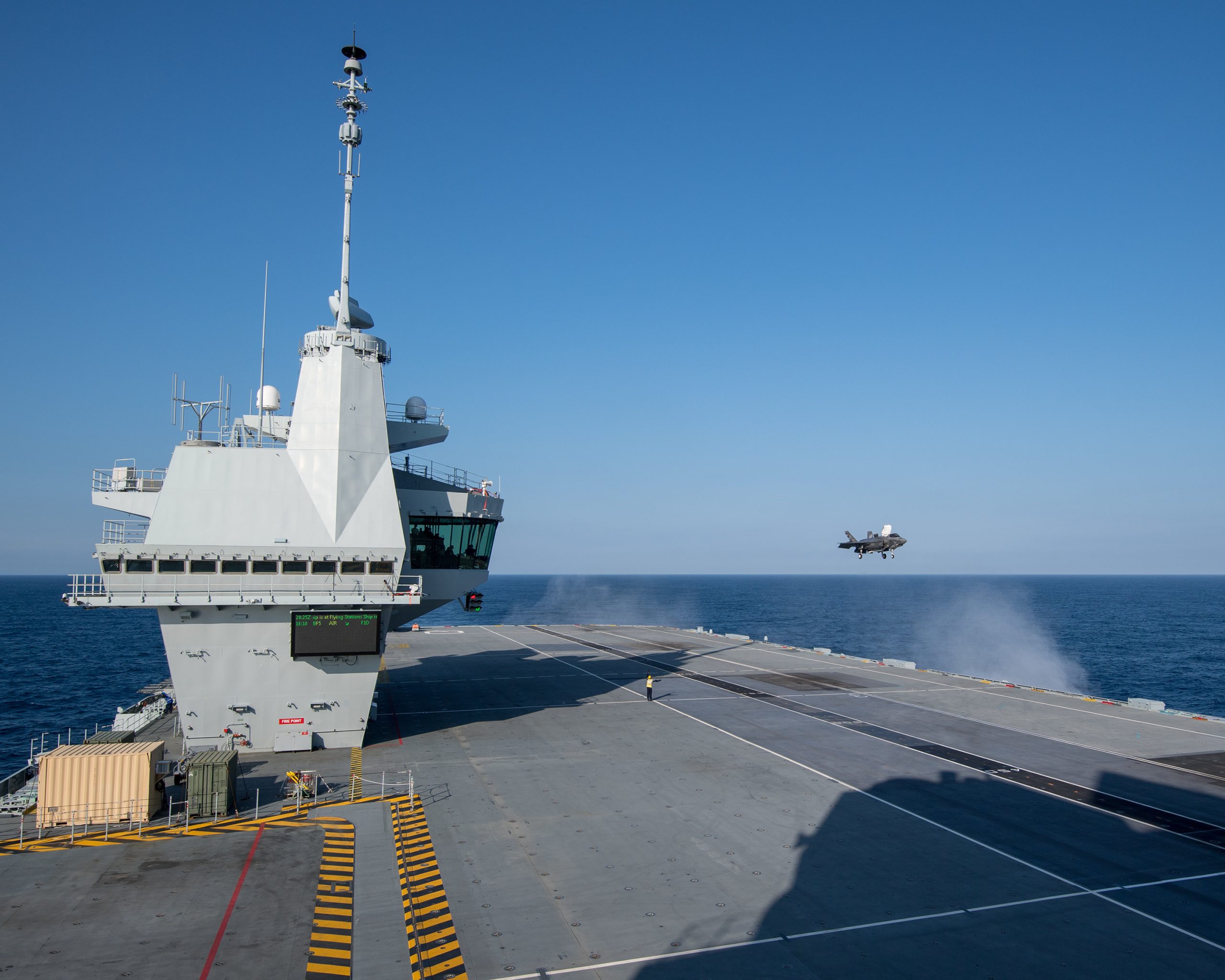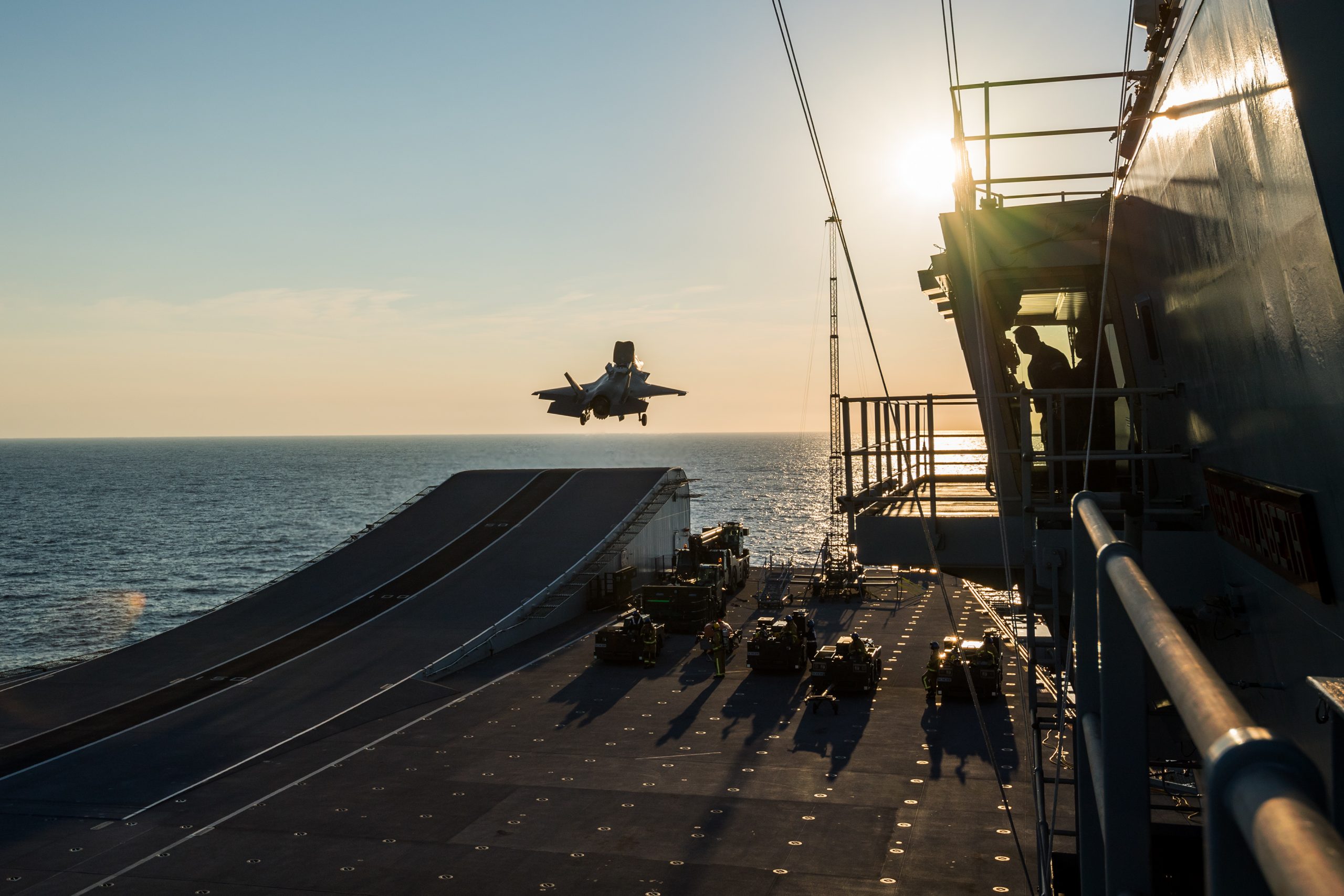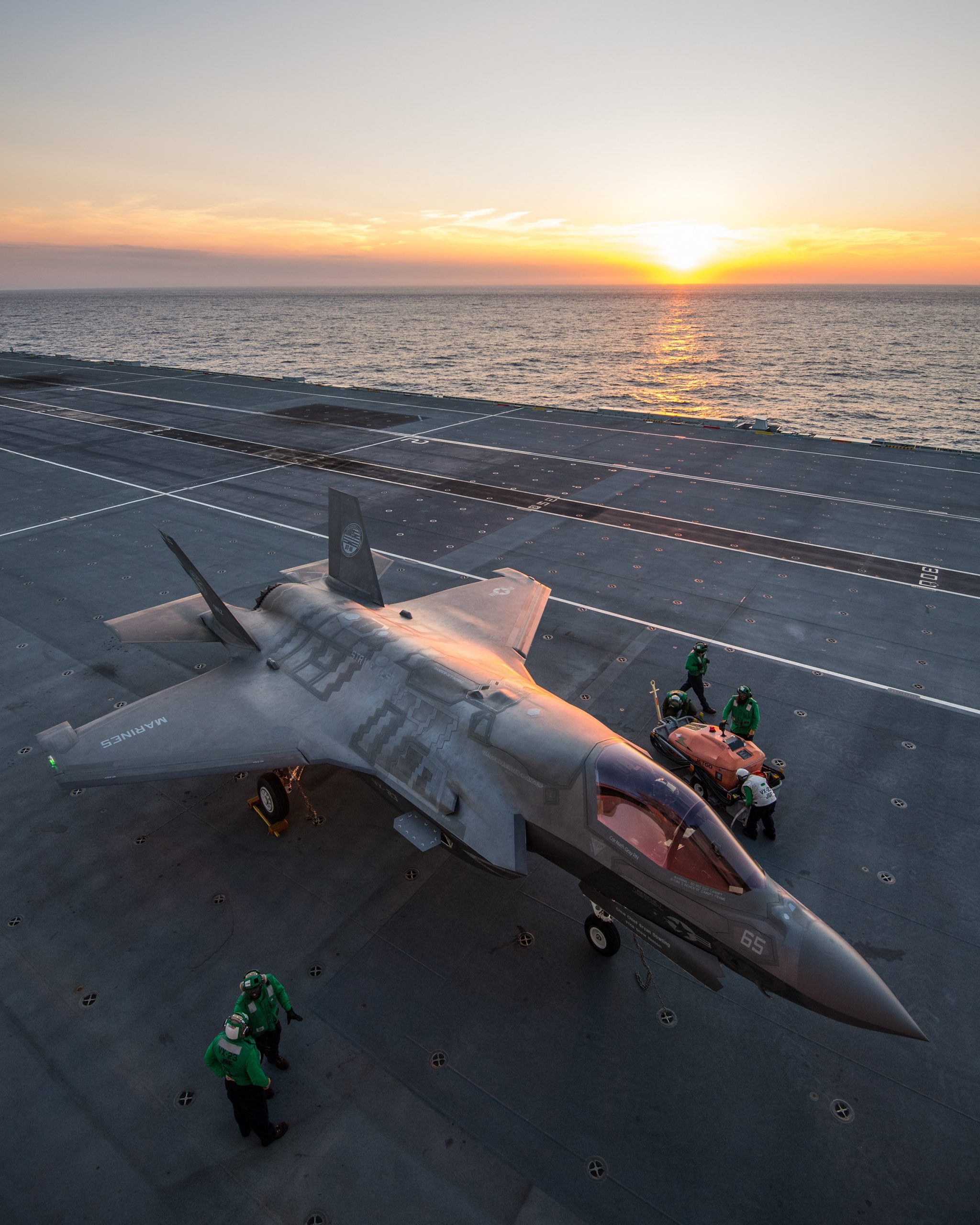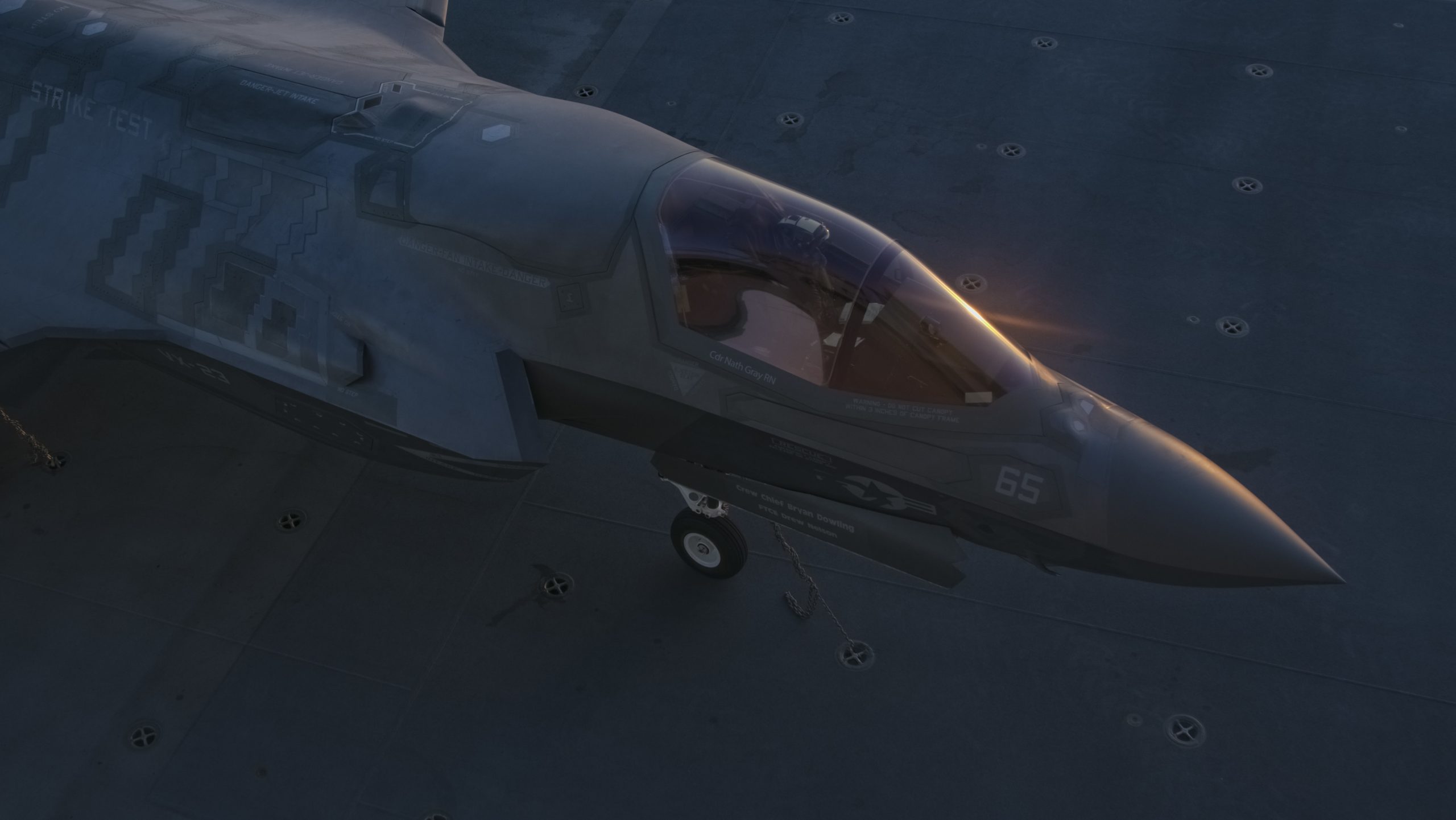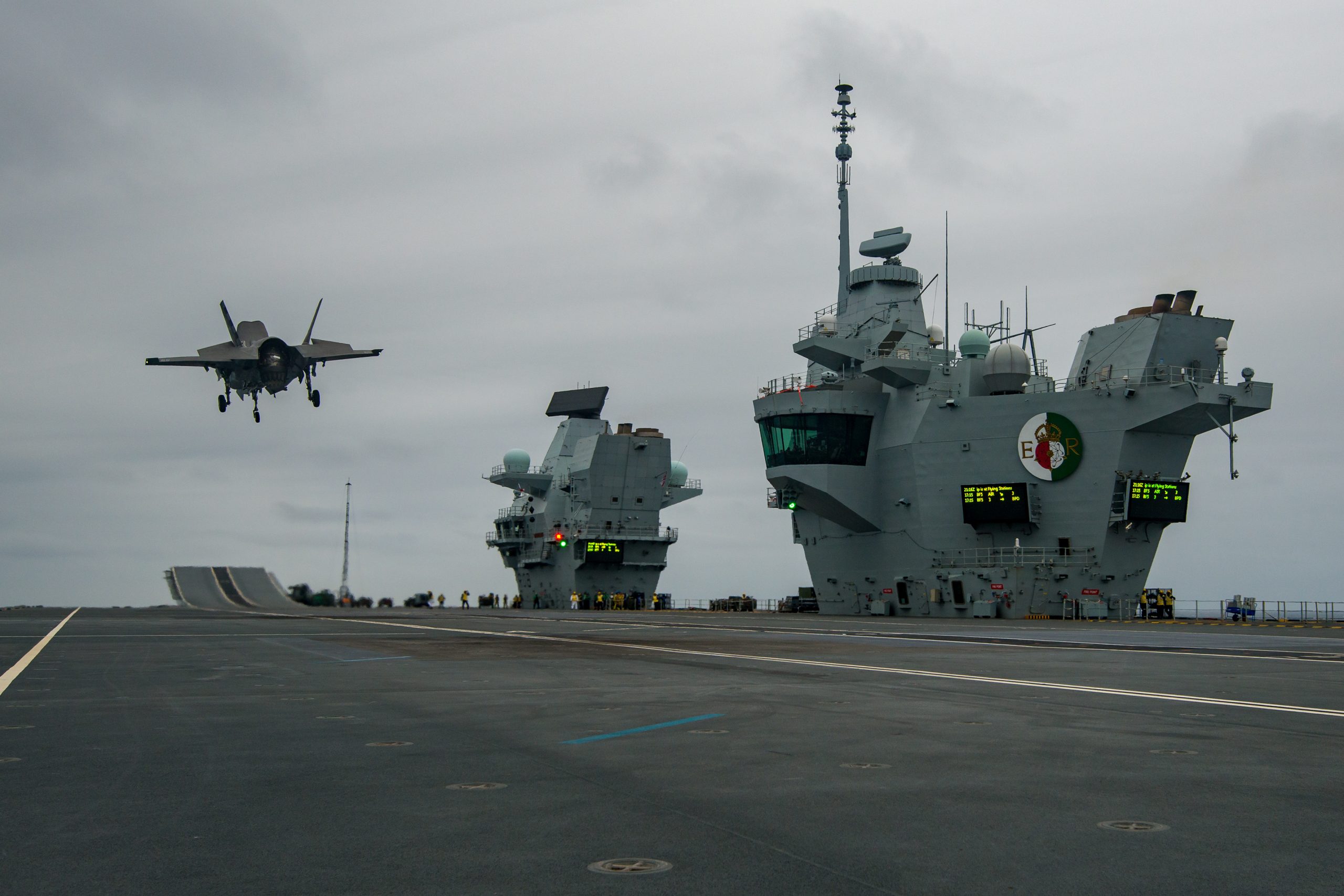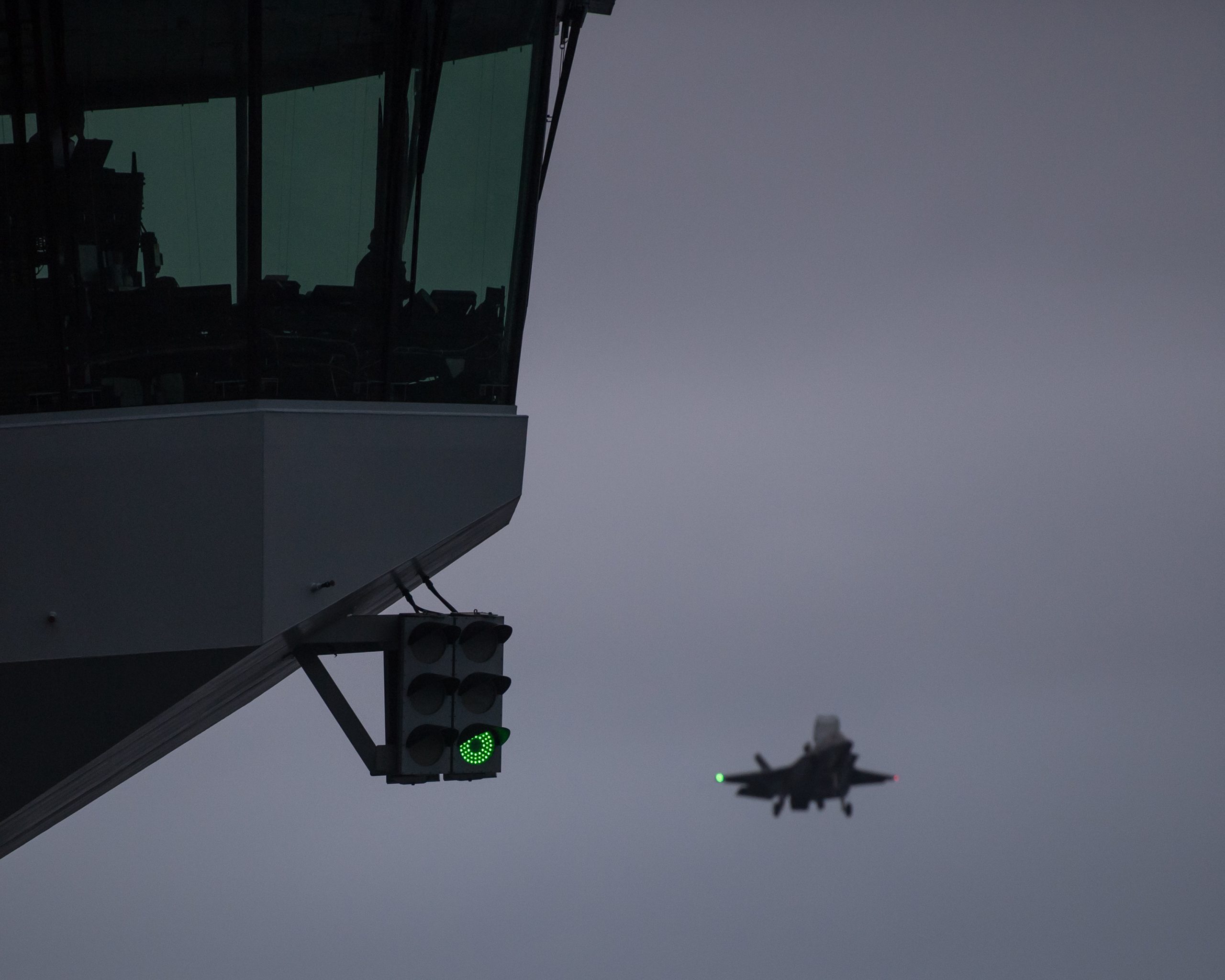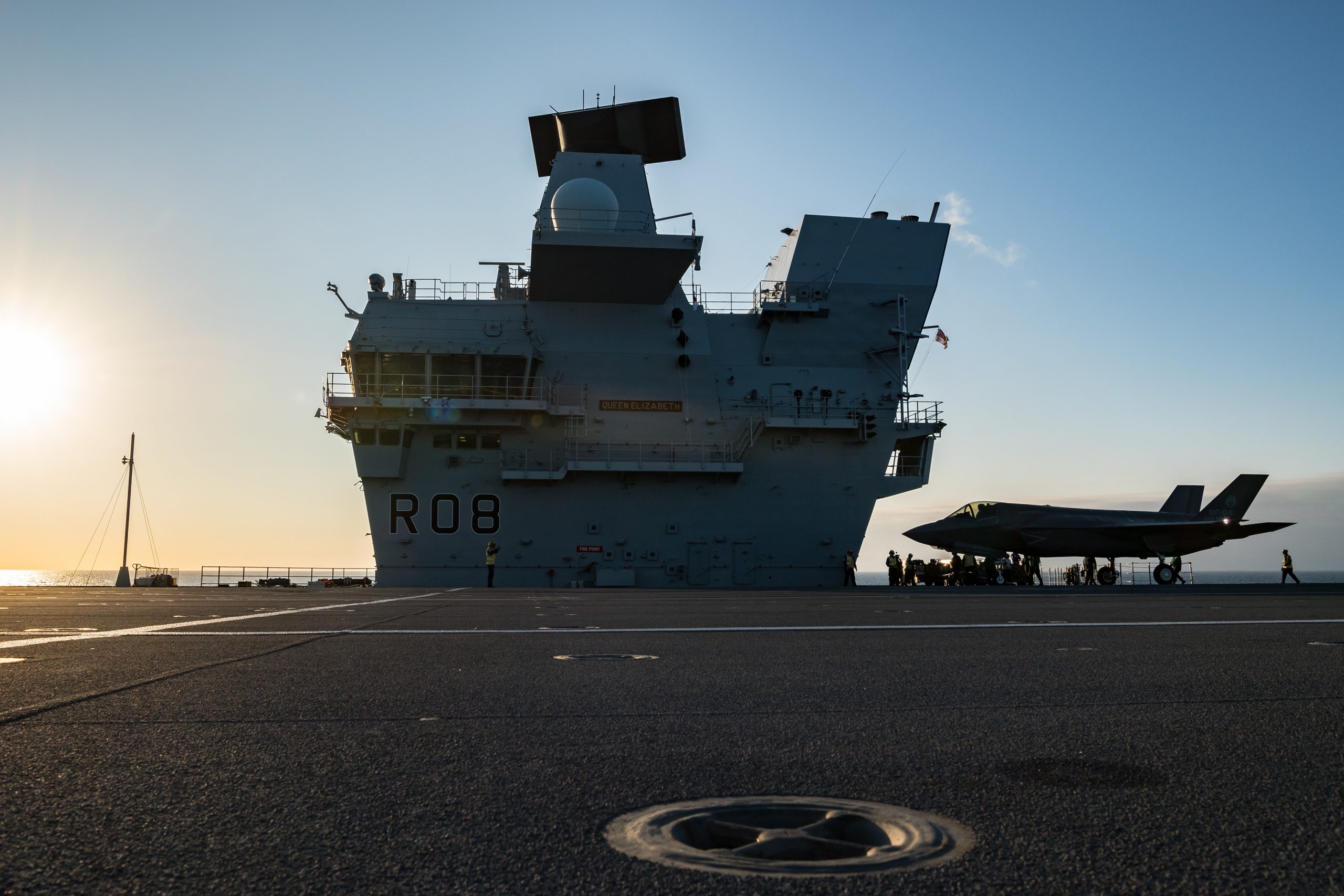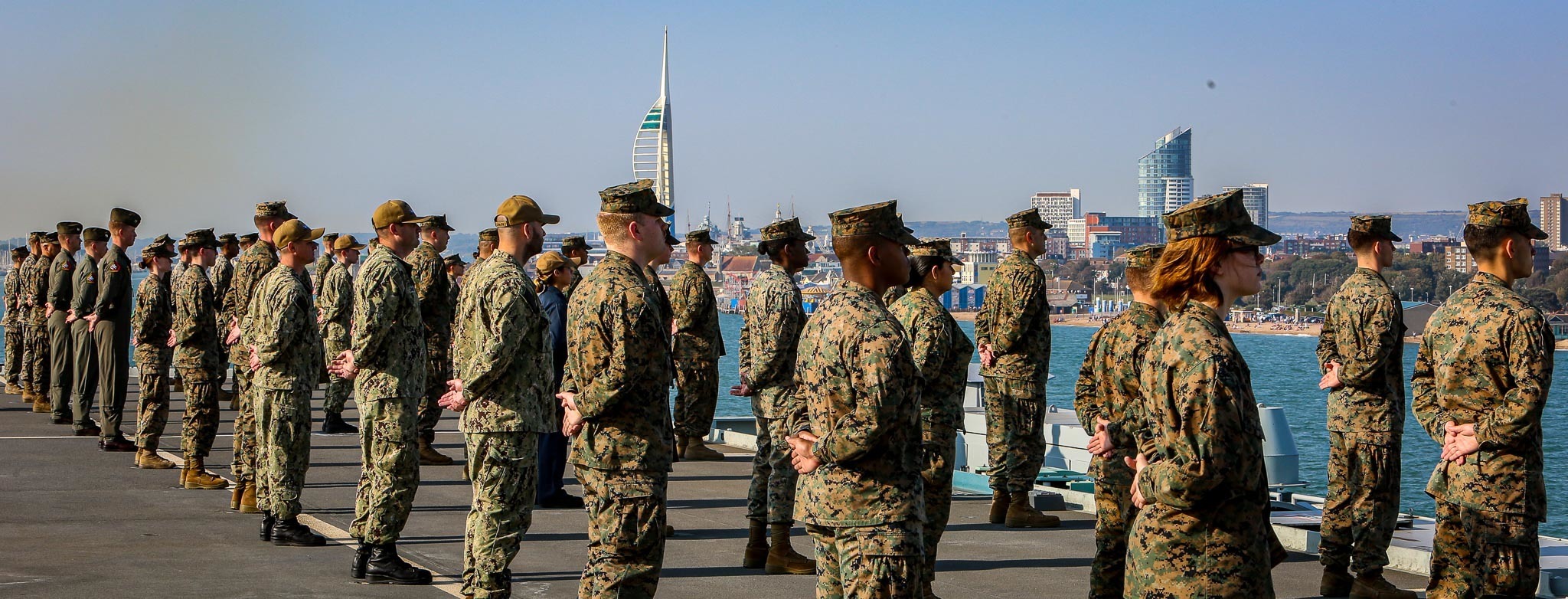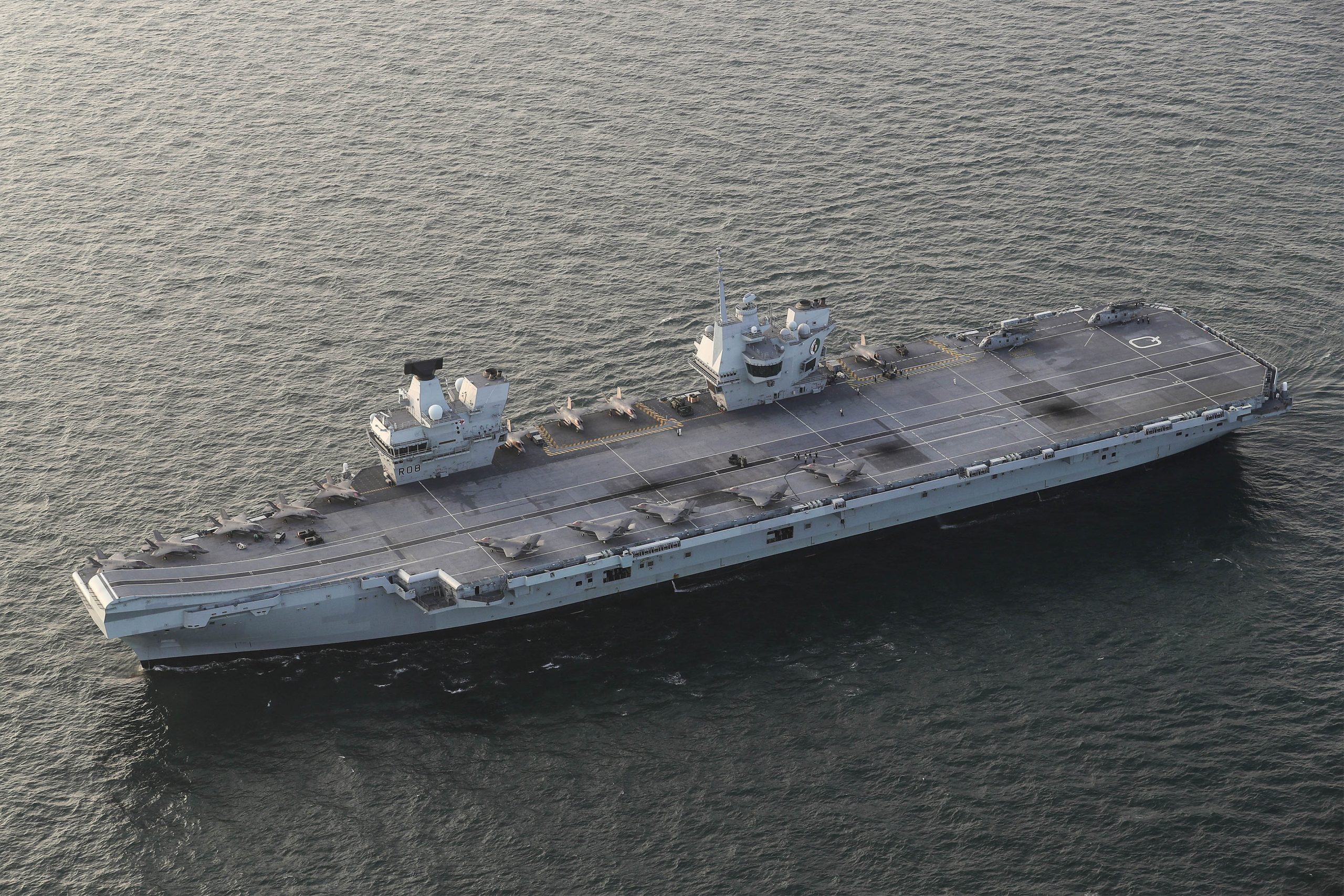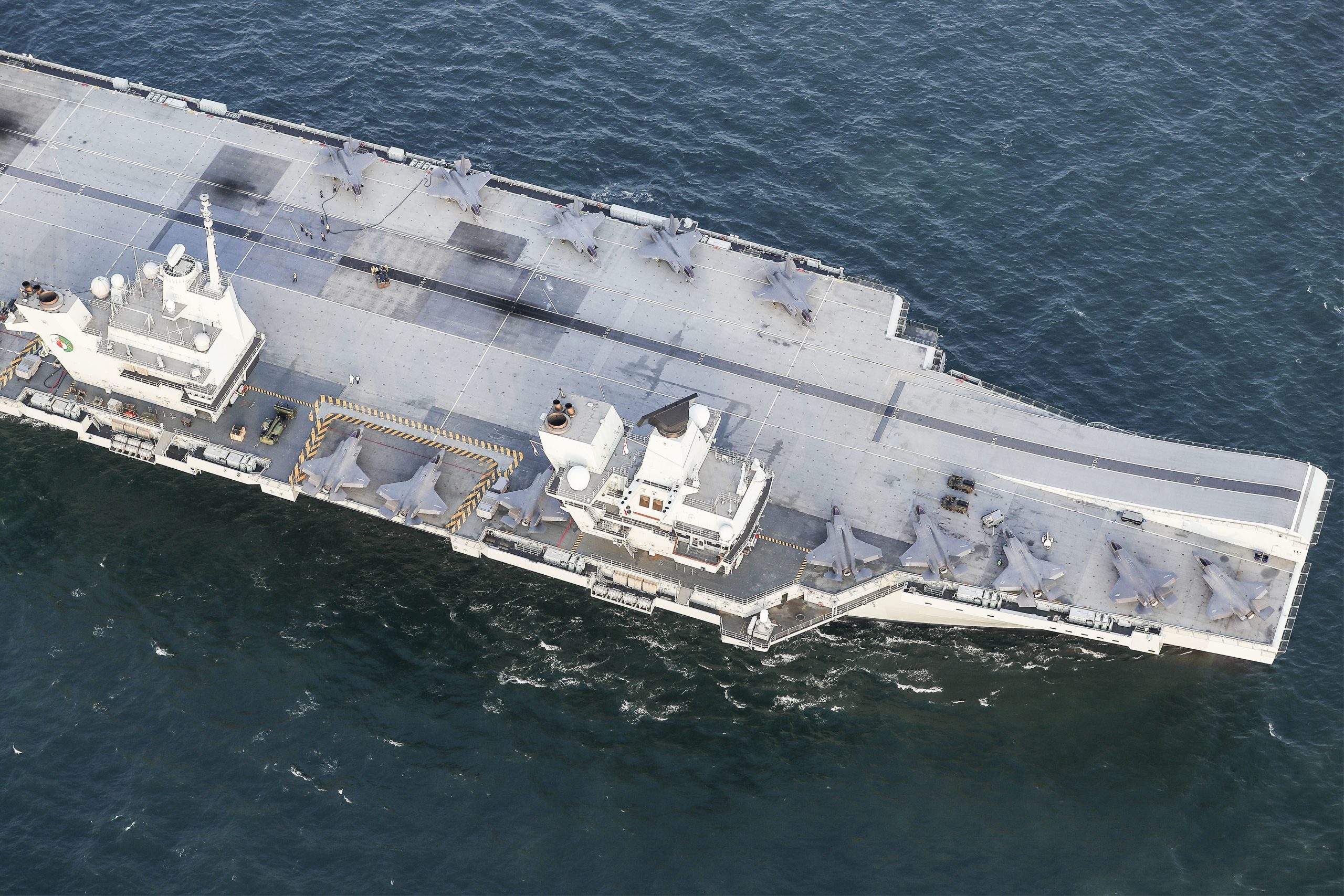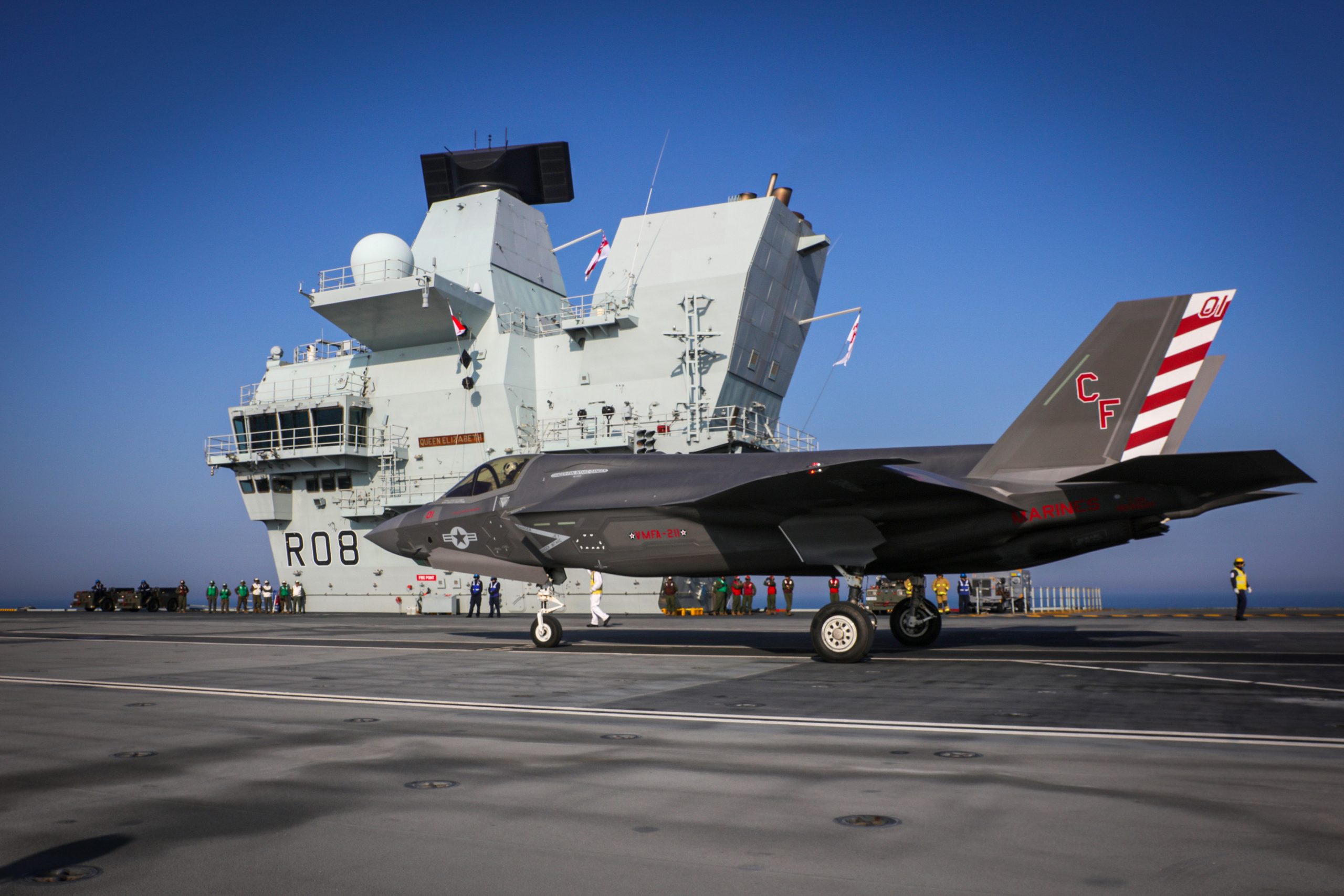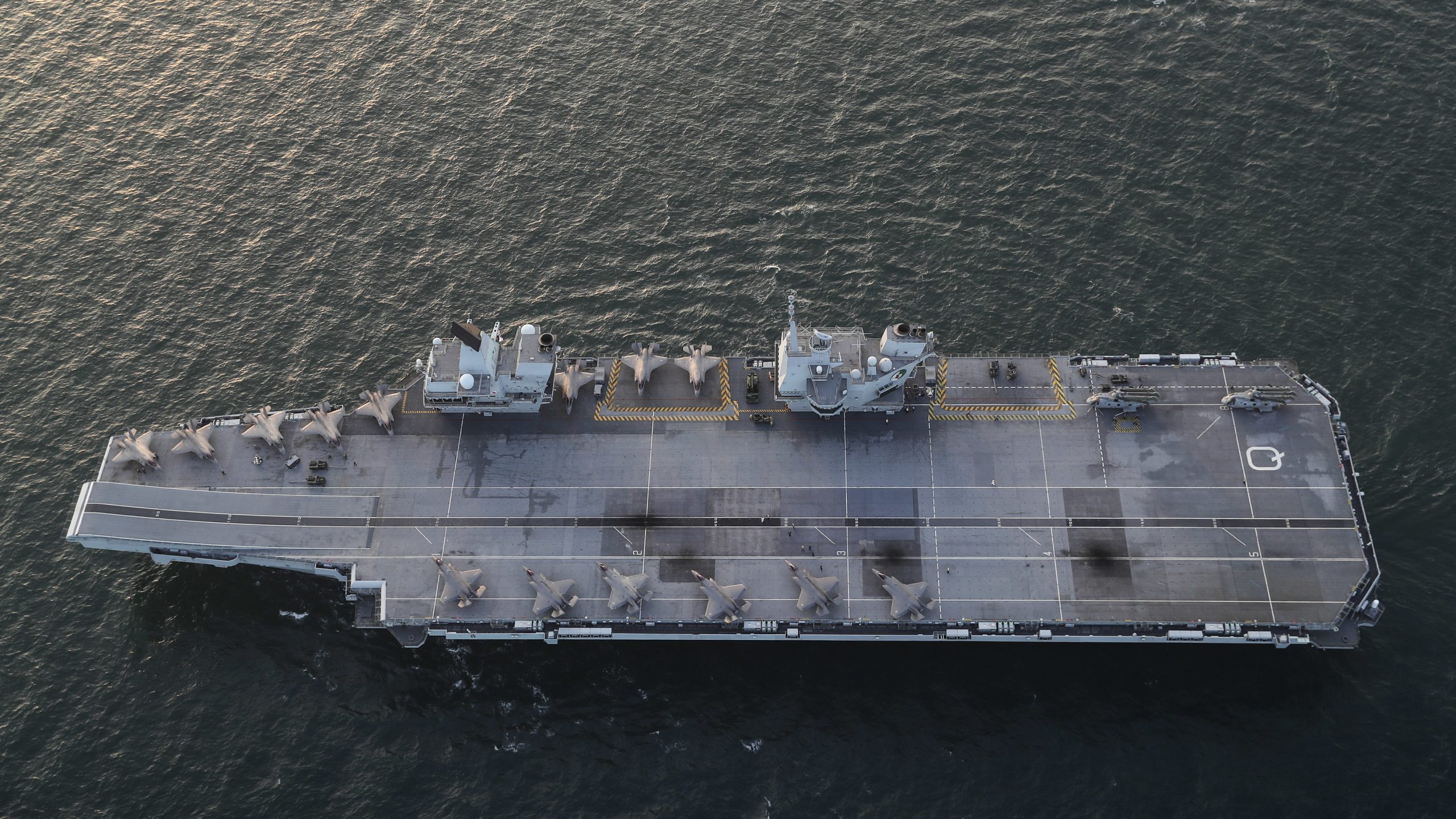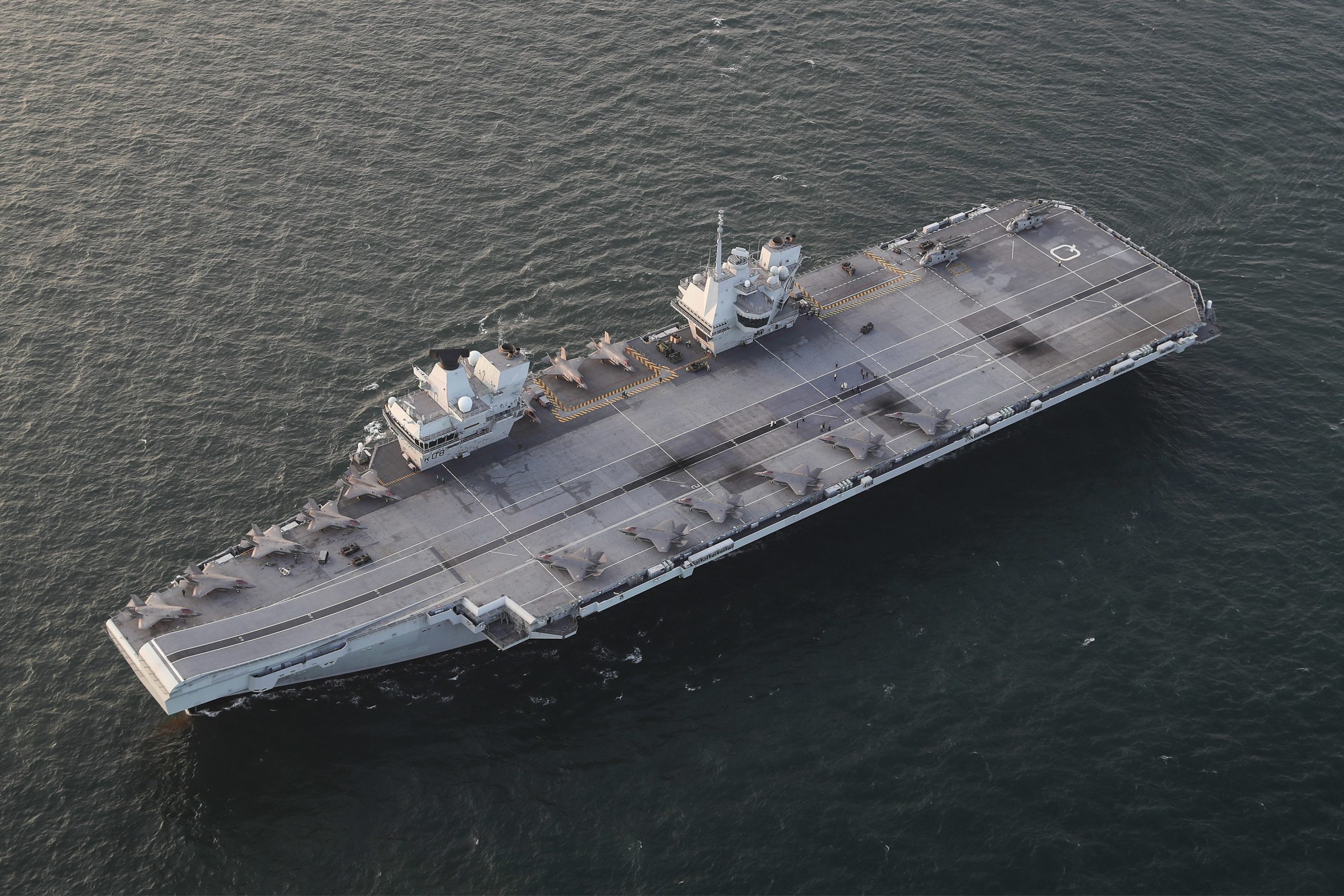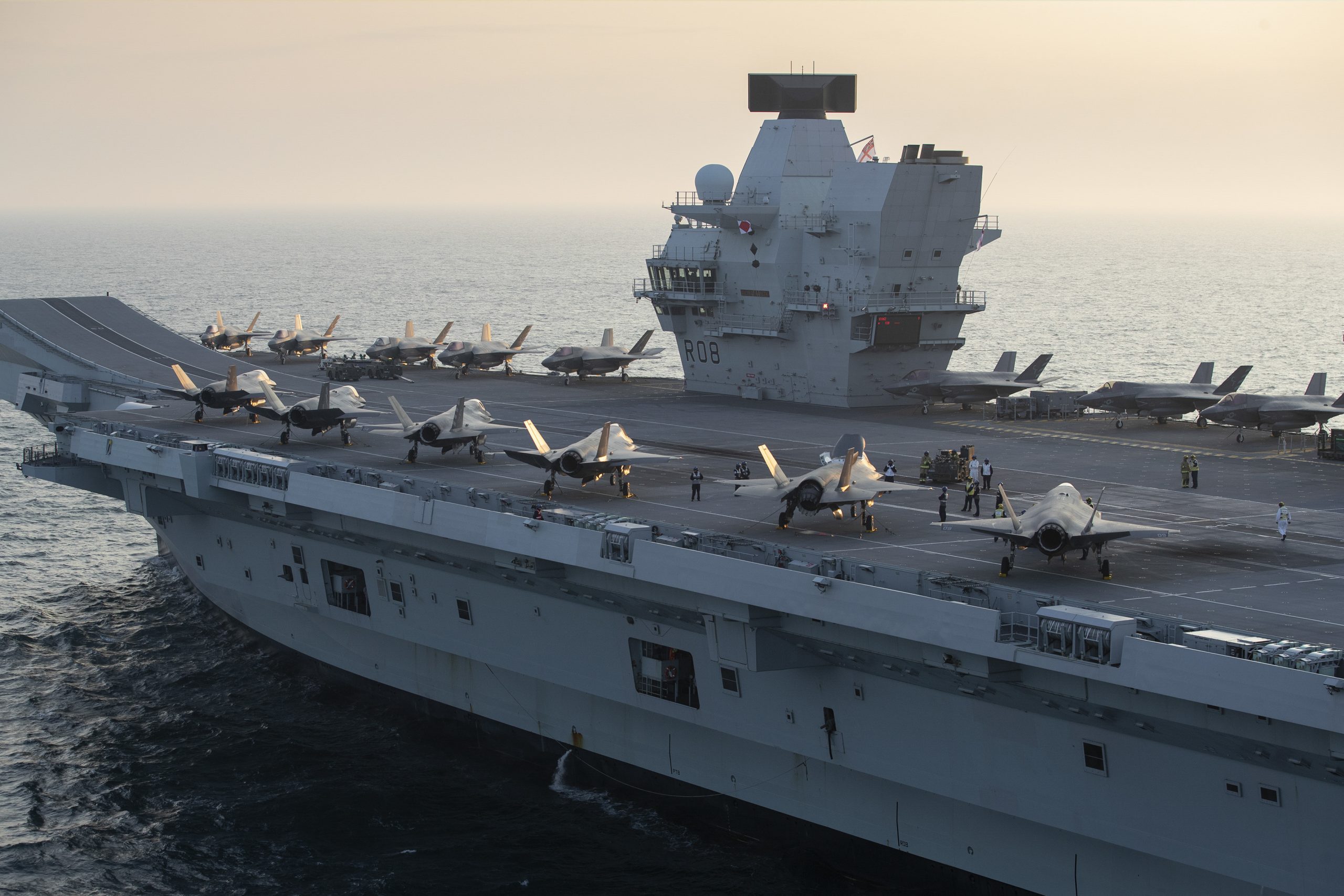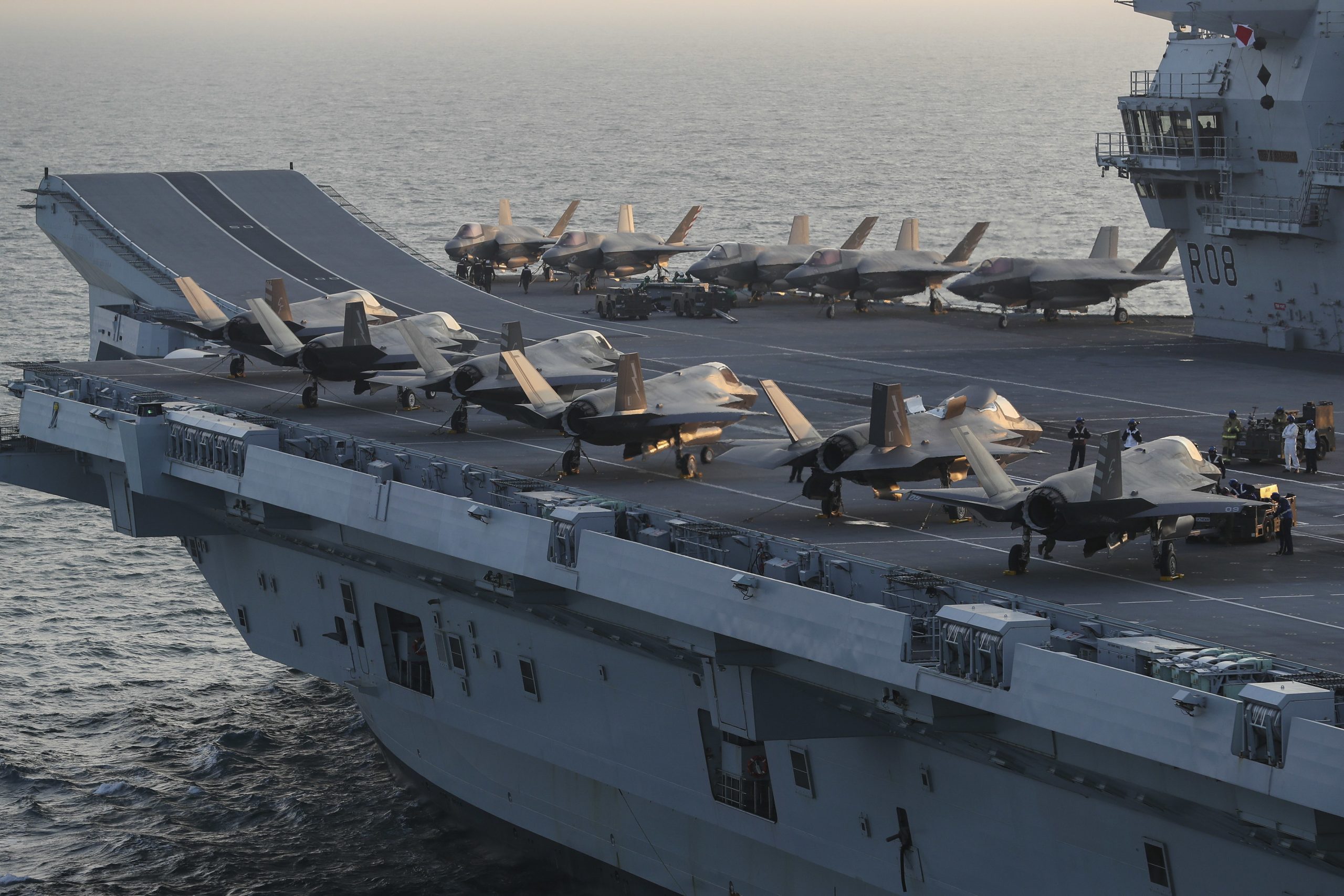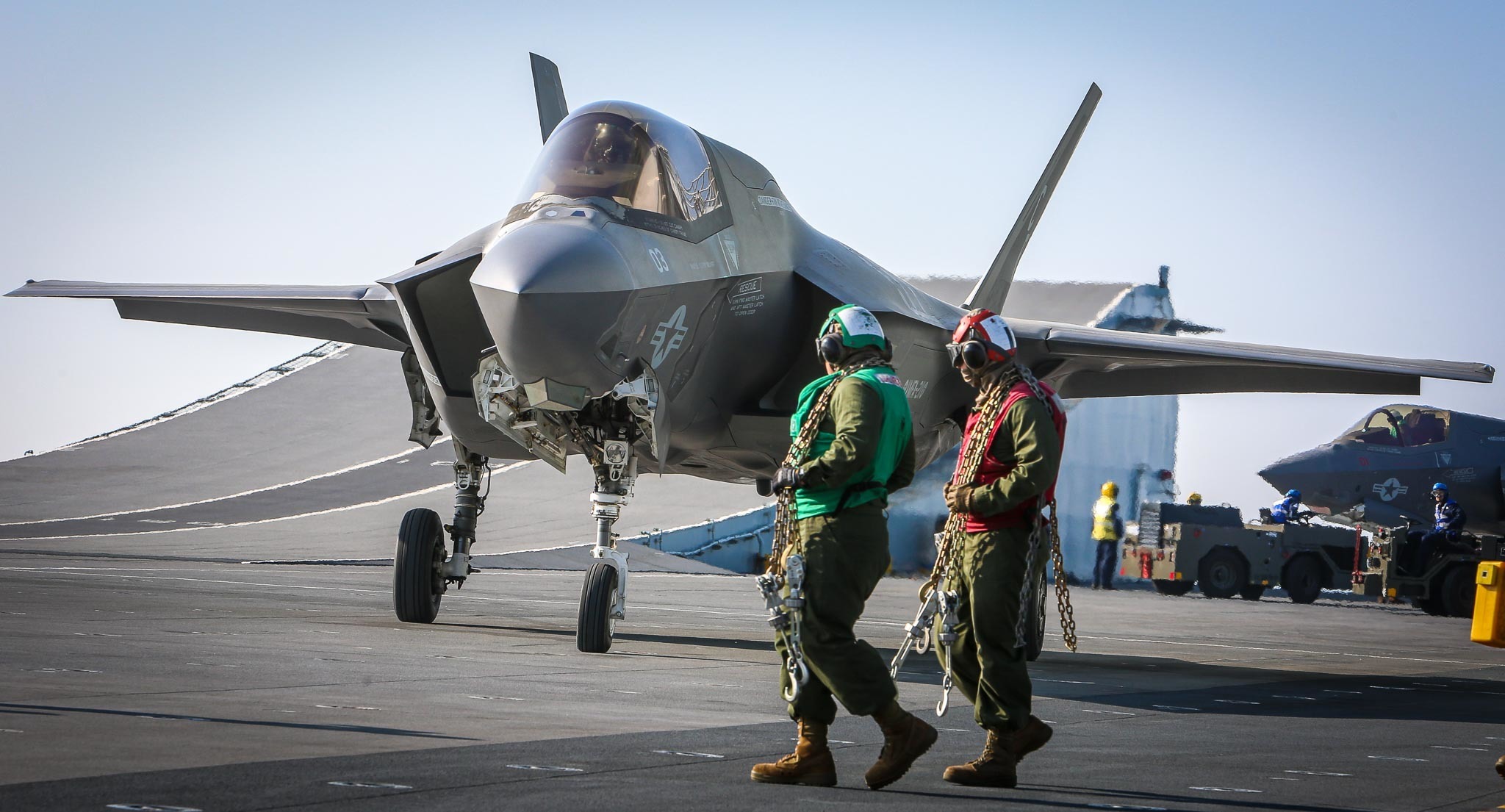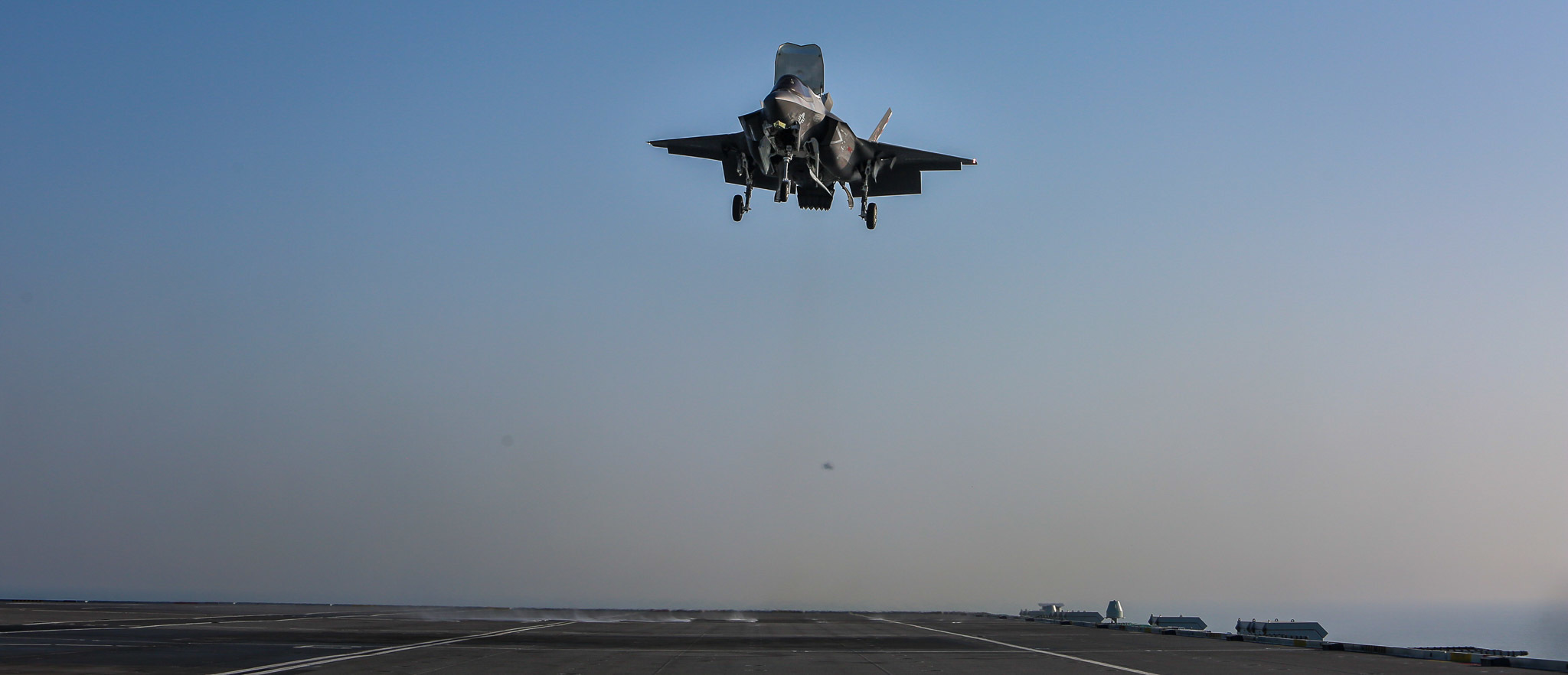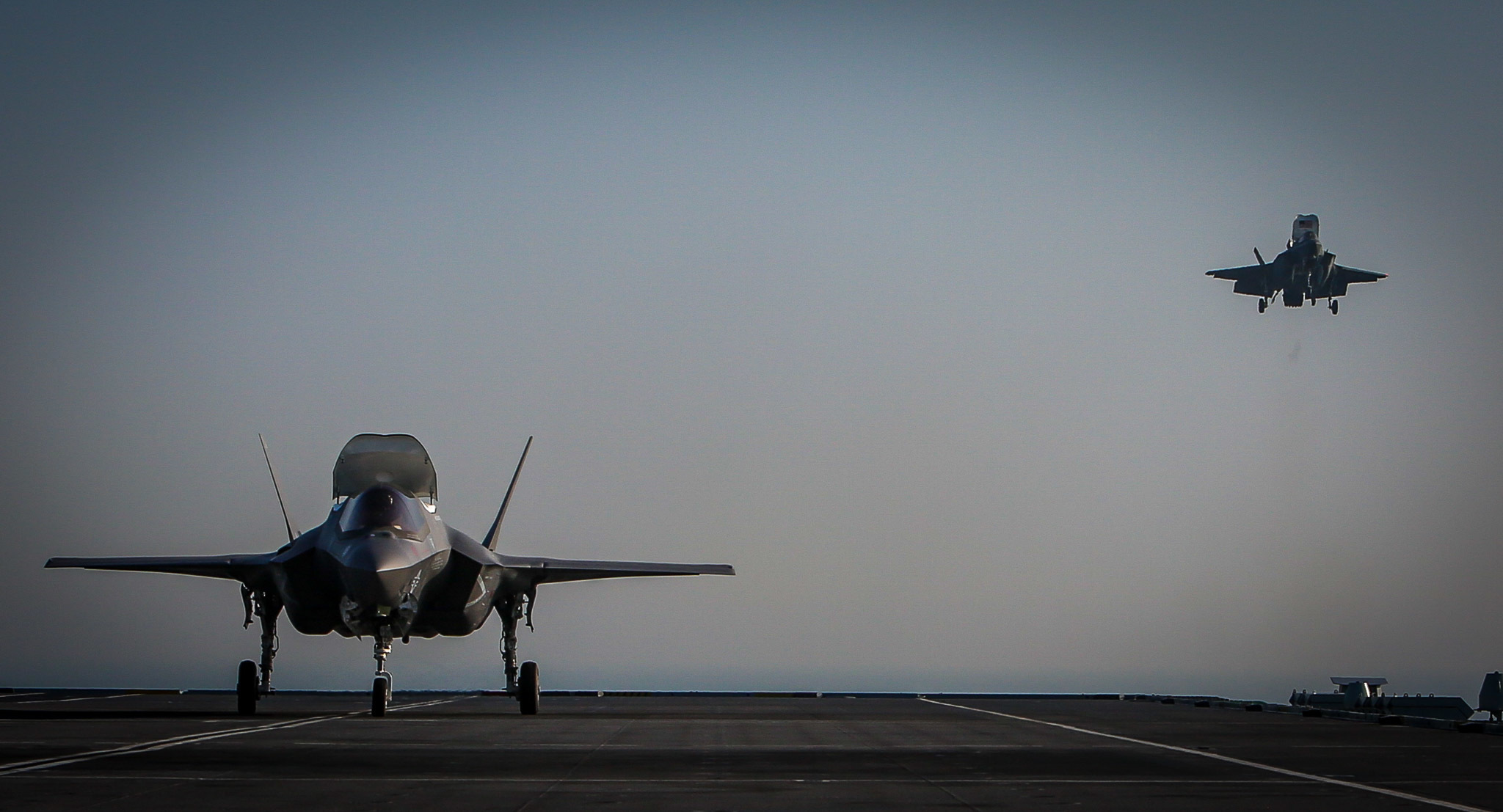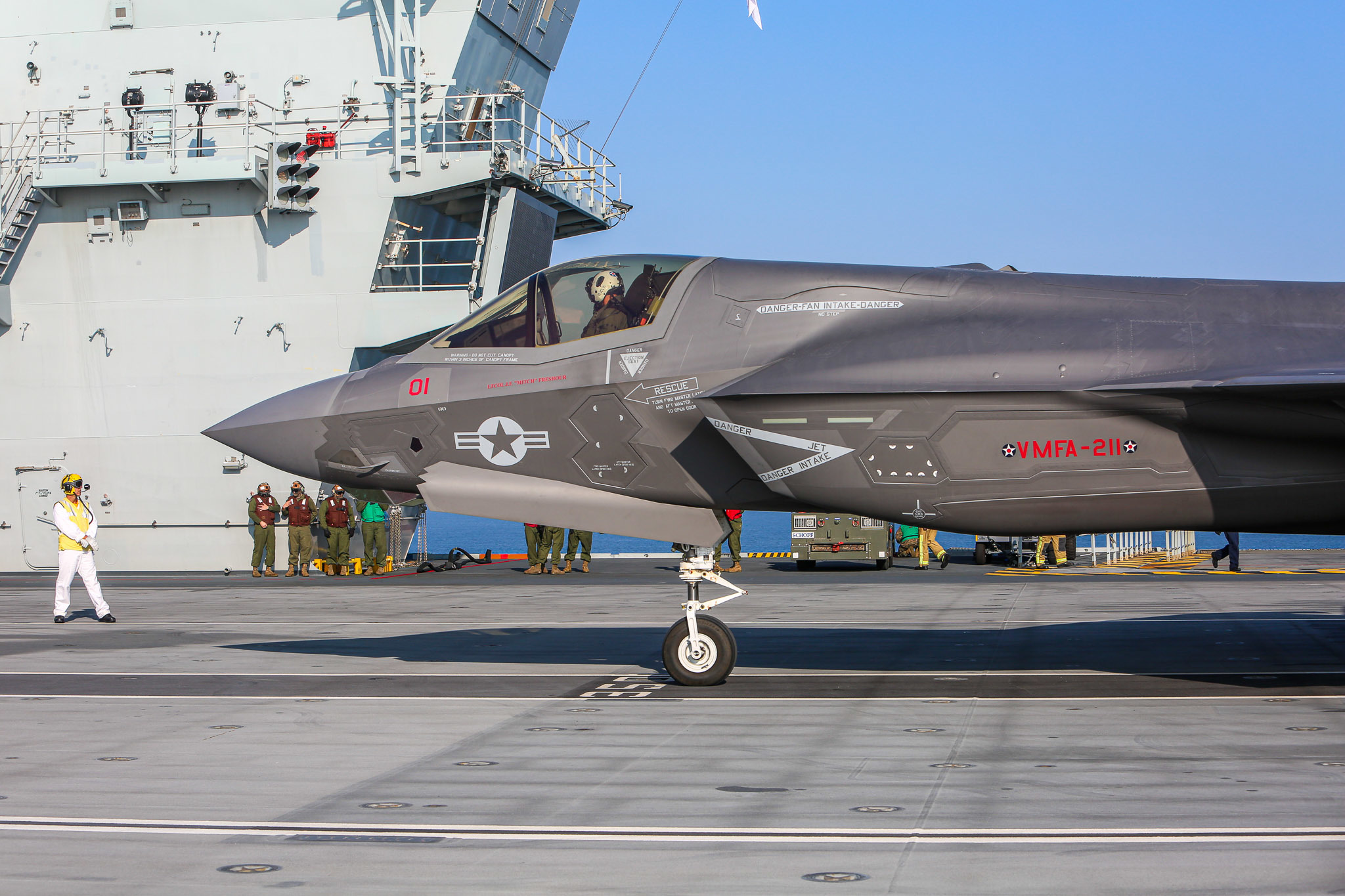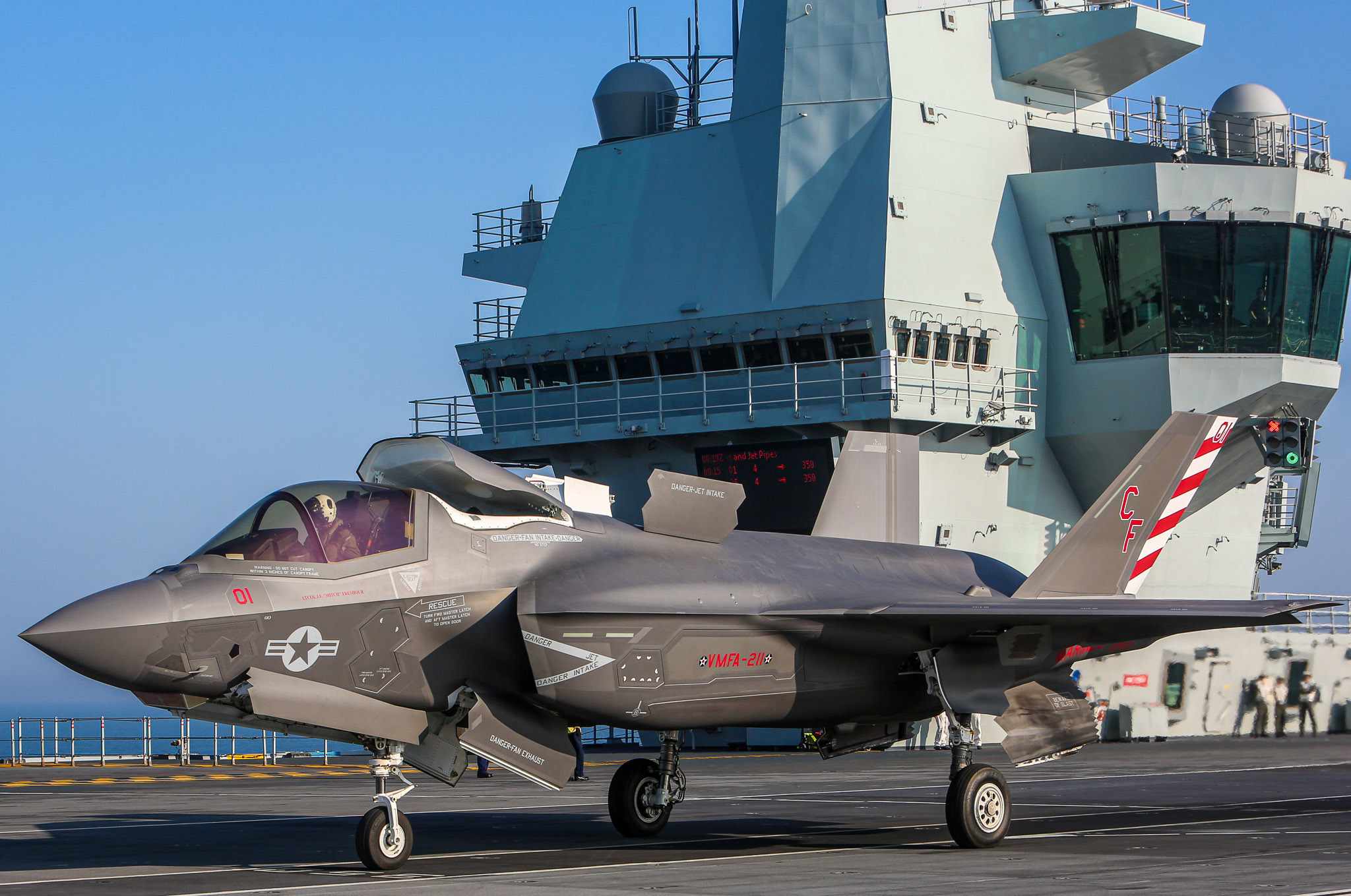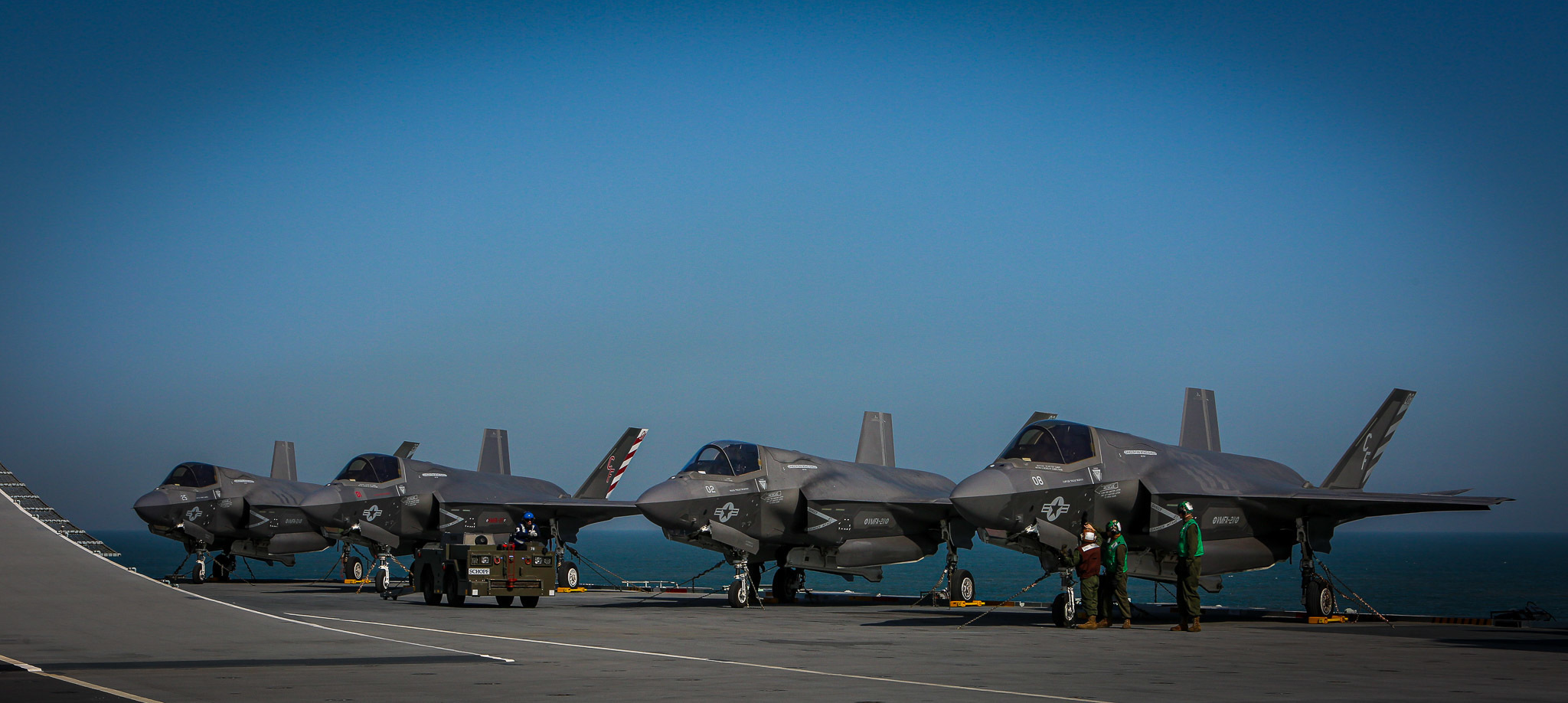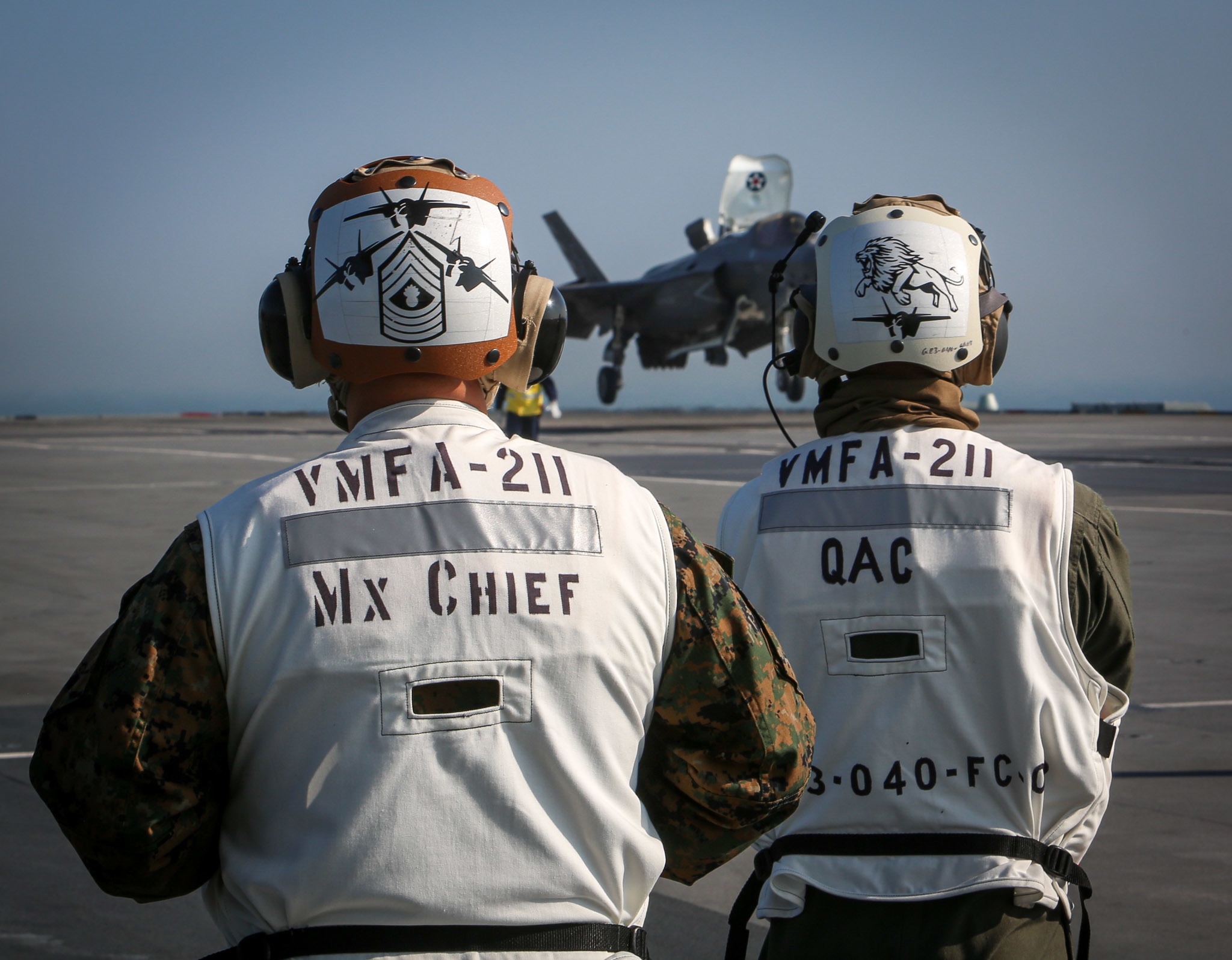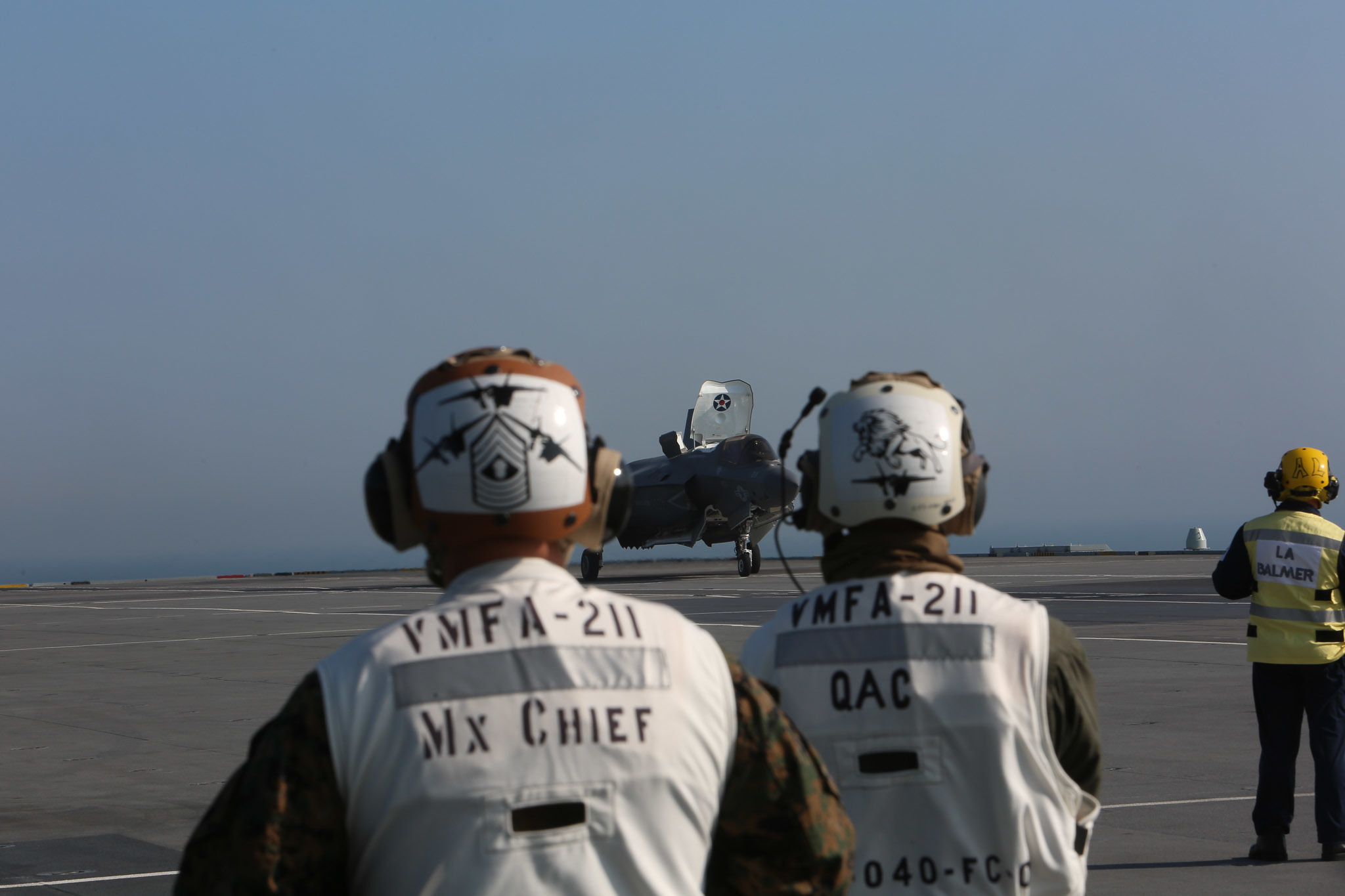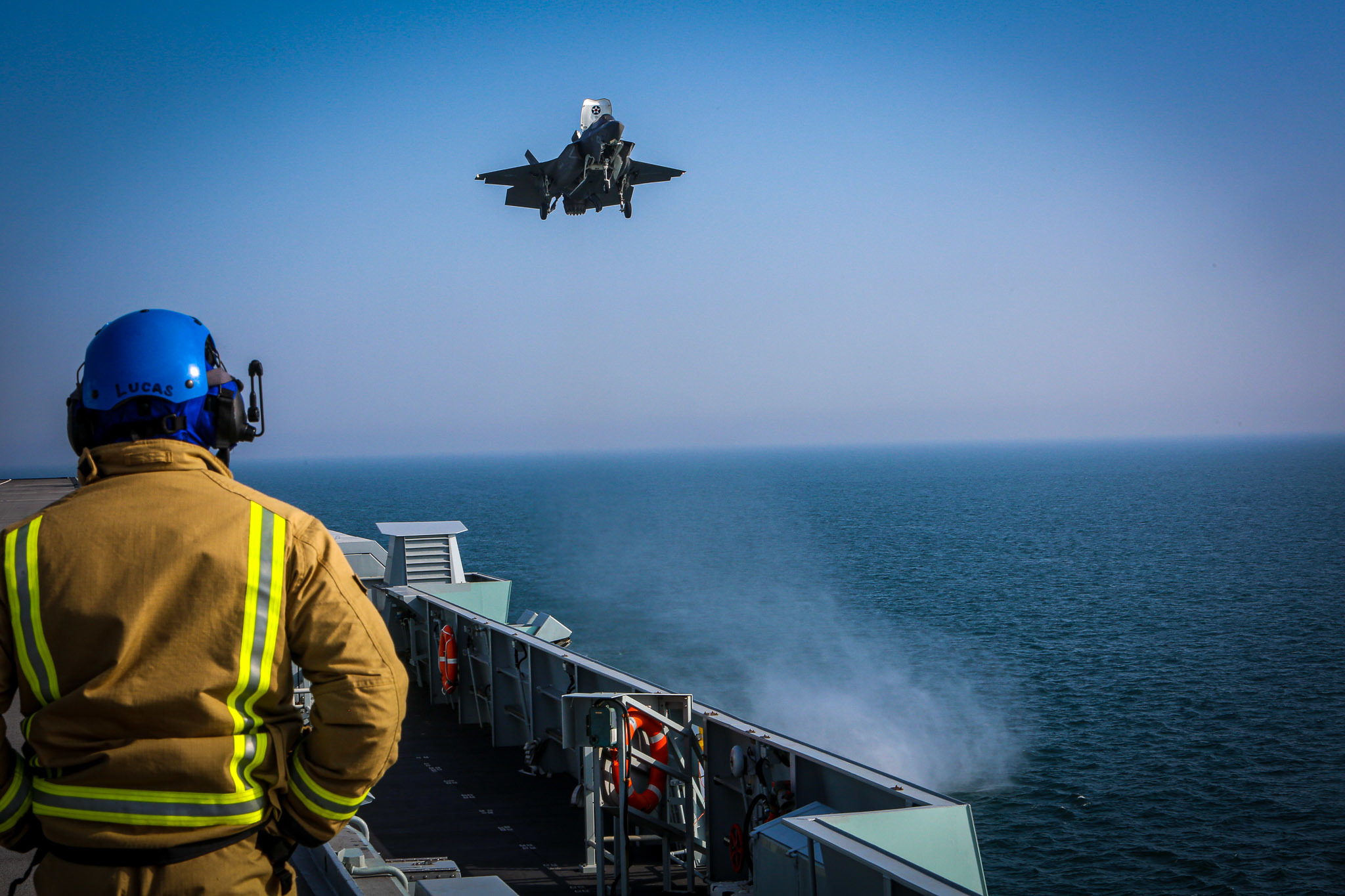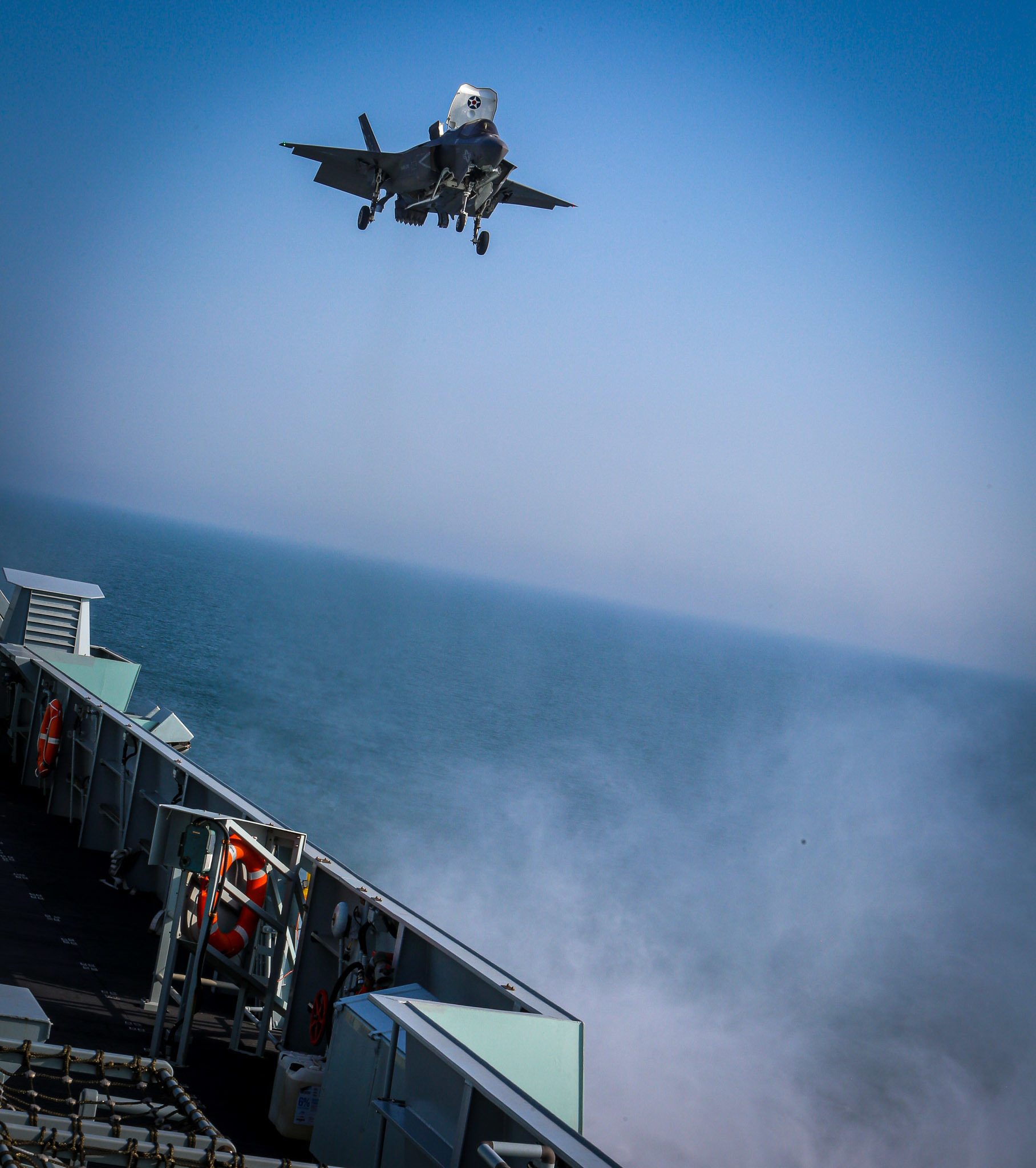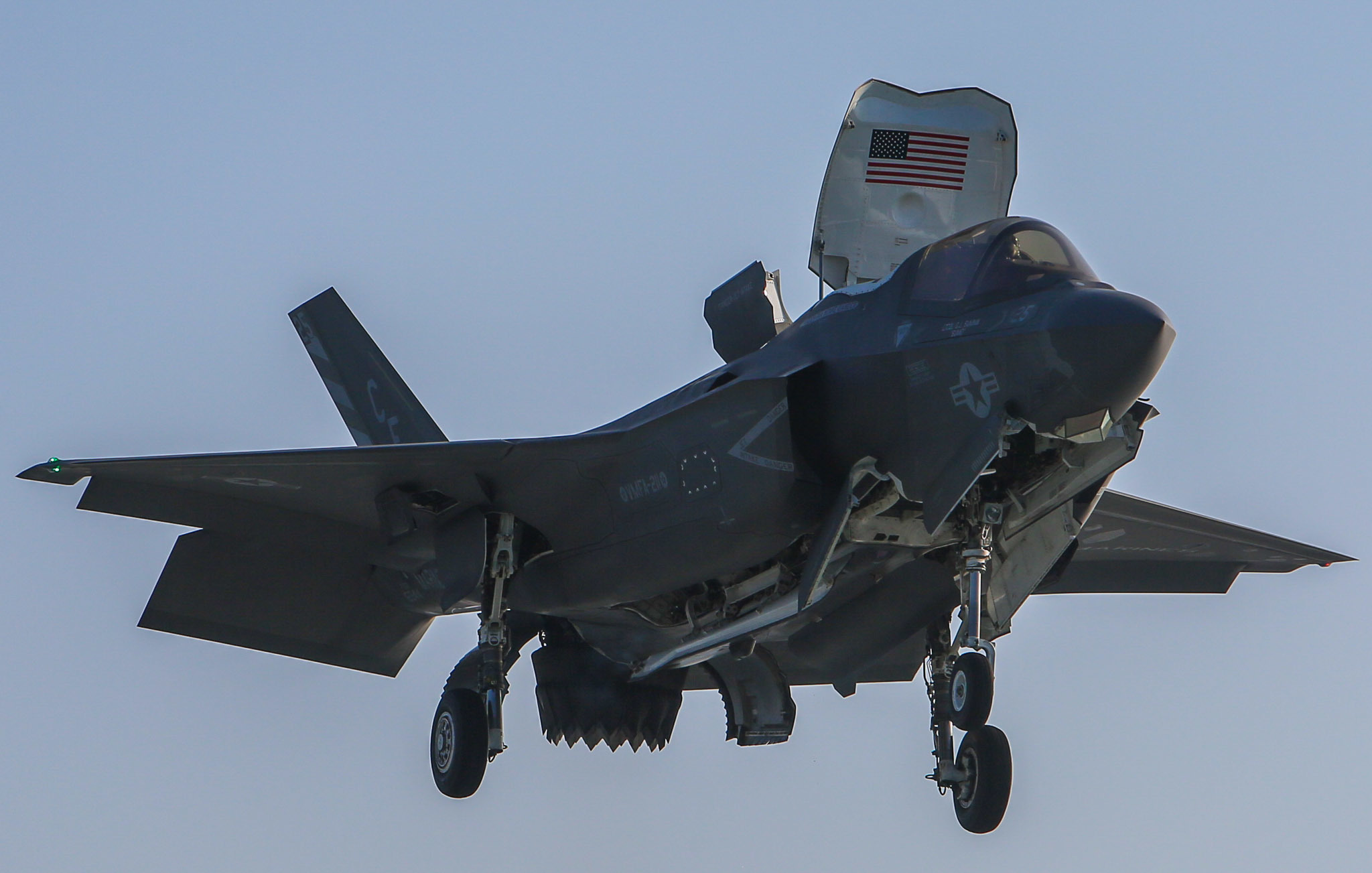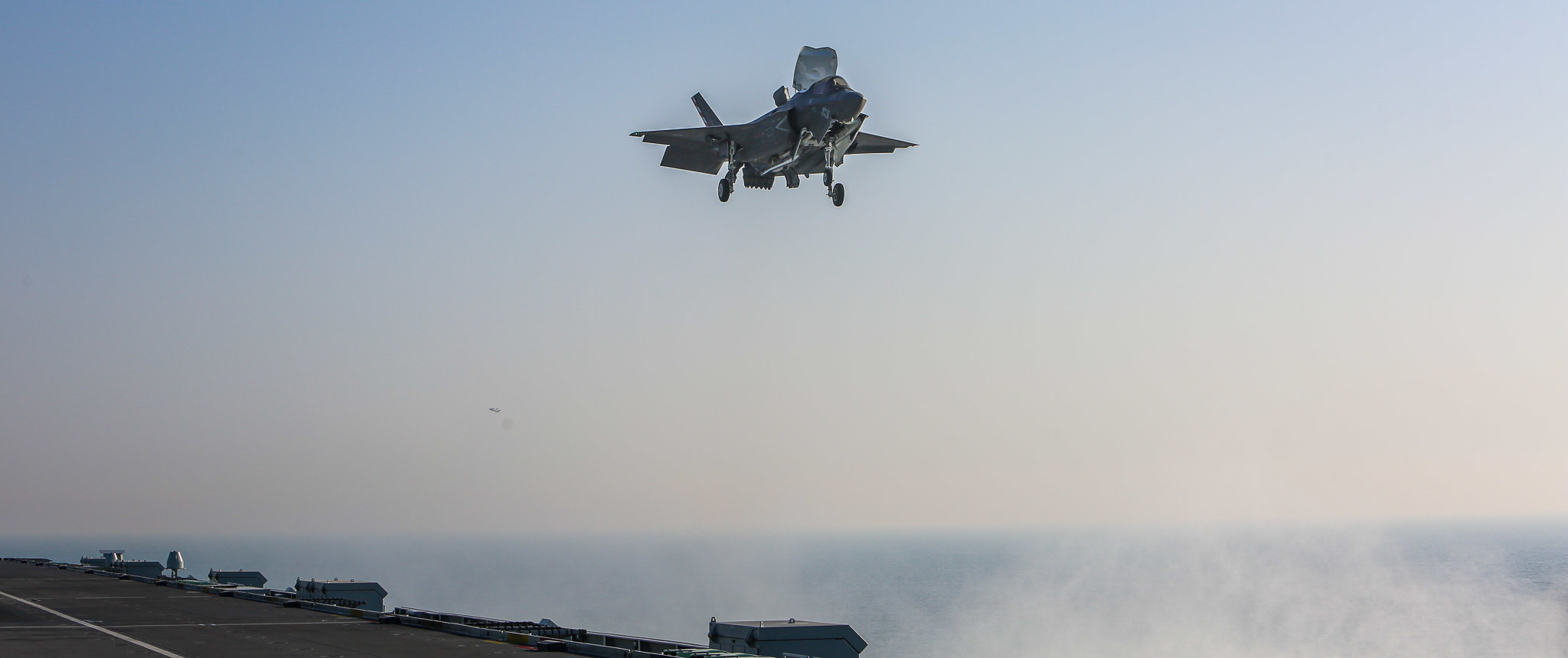By Robbin Laird
In this September 23, 2020 story published by 3rd Marie Aircraft Wing, the historic deployment of USMC F-35Bs onboard the UK’s largest warship ever built by the UK was highlighted.
PORTSMOUTH, England — Marine Fighter Attack Squadron 211 embarked 10 F-35B Lightning II Joint Strike Fighters onboard Her Majesty’s Ship Queen Elizabeth, September 22, as part of the squadron’s multi-month deployment for training to the United Kingdom. “The Wake Island Avengers” are proud to represent the United States Marine Corps and United States of America while they serve as part of the UK’s Carrier Strike Group.
“HMS Queen Elizabeth will be operating with the largest air group of 5th generation fighters assembled anywhere in the world,” said Commodore Steve Moorhouse, Commander UK CSG. “Led by the Royal Navy, and backed by our closest allies, this new Carrier Strike Group puts real muscle back into NATO; and sends a clear signal that the United Kingdom takes its global role seriously.”
VMFA-211 joined the UK’s 617 Squadron “The Dambusters” onboard the 65,000-ton carrier as she sailed for exercises with NATO allies in the North Sea. This month’s overarching UK-led Group Exercise will see VMFA-211, 617 Squadron and HMS Queen Elizabeth joined by six Royal Navy destroyers, frigates and auxiliaries, ready to fight in any clime or place.
In addition to these forces, the UK CSG will be joined by warships from the Royal Netherlands Navy and US Navy to form the largest UK-led multi-national force in recent years, which will accompany HMS Queen Elizabeth on her global, inaugural deployment in 2021.
“This is the Special Relationship in action,” said Robert Wood Johnson, U.S. ambassador to the United Kingdom. “Our forces train, fight, and win – side by side – to protect our two countries.”
Before the deployment, the CSG will be put through its paces off the north east coast of Scotland as part of Joint Warrior, NATO’s largest annual exercise. Joint Warrior will be an opportunity for the CSG to exercise the capabilities of 15 5th generation F-35Bs flown by VMFA-211 and Squadron 617. The F-35B combines next-generation fighter characteristics of radar-evading stealth, sensor fusion, fighter agility and advanced logistical support with the most powerful and comprehensive integrated sensor package of any fighter aircraft in history, providing unprecedented lethality and access to highly contested environments.
“During this special partnership, the US Marine Corps and US Navy will conduct carrier strike group operations, training to maritime power projection, and ultimately supporting shared security,” said Doran. “Our alliance is stronger because we can deploy and fight together as truly integrated NATO allies.”
This exercise is a historic moment for the United Kingdom and the United States which strengthens the special relationship between the two countries. For the UK, it will be the largest air group to operate from a Royal Navy carrier since HMS Hermes in 1983; as well as the next step leading toward HMS Queen Elizabeth’s worldwide deployment this spring. For the United States, it is the first time a squadron of 5th generation aircraft will be deployed aboard a foreign vessel and will prove that the “Wake Island Avengers” are ready to conduct operations in support of NATO.
The “Wake Island Avengers” made history in 2018 when the squadron completed the first F-35B combat deployment, successfully supporting ground operations in Central Command’s area of responsibility.
“The Wake Island Avengers are ready in all respects to work with the British sailors and aircrew onboard HMS Queen Elizabeth,” said Lt. Col. Joseph Freshour, the commanding officer of VMFA-211. “We are looking forward to deploying alongside our British counterparts.”
VMFA-211 deployed for training to Royal Air Force Station Marham in the early evening of September 3. The pilots flew from Marine Corps Air Station Yuma, Arizona to MCAS Beaufort, South Carolina, and then onto RAF Mahram, a distance of 5500 nautical miles. Since then, VMFA-211 has been conducting realistic, relevant training at RAF Marham with “The Dambusters.”
While serving as part of the UK Carrier Strike Group, VMFA-211 will use innovative techniques to combine efforts and resources while collaborating on complex mission sets to maintain our Nations’ global maritime military advantage. The Navy-Marine Corps team is humbled and proud to represent the United States and continue the special relationship with the United Kingdom in support of shared security.
But looking back, this partnership almost did not happen.
10 years ago this month, the UK government announced that they were pulling out from the F-35B program to buy F-35Cs, and to redesign their new carriers to use catapults, namely, the new electronic catapults planned by the US Navy for the USS Ford class.
As part of the UK’s 2010 strategic review, the government committed to rebuilding their new carriers to enable “cats and traps” as the launch mechanism, and the purchase of F-35Cs versus F-35Bs.
This decision left the USMC in a very difficult situation within the Pentagon at the time, ramping up pressure on their F-35B purchases.
Suggestive of the position the UK decision to move to the C versus the B put the Marines in is found in the analysis in this March 26, 201 article by Robert F. Dorr:
“New details have emerged about plans for the “mix” of F-35B and F-35C Lightning II Joint Strike Fighters (JSF) that the U. S. Marine Corps will operate. At the same time, some in Washington are questioning whether the short takeoff/vertical landing (STOVL) F-35B version may be in jeopardy.
“Gen. James F. “Tamer” Amos, commandant of the Marine Corps, defends the F-35B, but acknowledges that its future is less clear than it once was. With their emphasis on ship-to-shore operations, the Marines have an enormous stake in STOVL, but in Washington some question whether the F-35B is worth the investment.
“Doubts arose about the viability of the F-35B before Britain dropped its plans for the STOVL version. Still, a major defense downsizing in the United Kingdom sharply reduces the number of the STOVL aircraft on order. Britain once wanted 150 F-35Bs, reduced the number to 138, and subsequently shifted to the F-35C carrier-based model in an economy move that also involves redesign of the first of two 65,000-ton Queen Elizabeth-class carriers.
“The only other committed user, Italy, wants 22 F-35Bs for its navy aircraft carriers, and 40 more for its air force. Observers in both Washington and Rome, however, are wondering whether the 40 air force aircraft will be built. If not, overall purchases of the STOVL F-35B would be cut in half at a time when questions about cost persist.”
As Lt. General (Retired) George Trautman put it today:
“Within days of the UK decision, the Commandant and I found ourselves in a fight for the mere existence of the F-35B.
“The program’s opponents in the US Navy, OSD and Congress, urged on by a false narrative from industry, were almost gleeful that we appeared to be isolated.
“Thankfully, we were able to defend the program and my prediction that the UK would return to STOVL turned out to be right just two years later.”
Now there are several F-35B users globally, with the prospect of others, precisely for the reason the USMC bought it, namely, deployment flexibility.
Lt. General (Retired) George Trautman added to his comment made today (October 18, 2020):
“Today, the the unique capabilities of the F-35B are widely recognized and the aircraft has been embraced by a growing number of nations.
Watching VMFA-211 and UK‘s 617 Squadron operate side-by-side on the HMS Queen Elizabeth is a wonderful endorsement of STOVL and the special relationship that exists between the two countries.”
As fixed airfields become higher risk propositions, an ability of an aircraft to fly from a wide variety of sites which can operate as airfields in a crisis, has become not a nice to have capability but a necessary one.
But by 2012, the UK government did a U-turn and recommitted to the F-35B.
The UK Defence Secretary at the time of the reversal, Philip Hammond noted:
“Carrier strike with ‘cats and traps’ using the carrier variant jet no longer represents the best way of delivering carrier strike and I am not prepared to tolerate a three-year further delay to reintroducing our carrier strike capability.
“This announcement means we remain on course to deliver carrier strike in 2020 as a key part of our Future Force 2020.”
The estimated cost of fitting the “cats and traps” system to HMS Prince of Wales had risen from £950m to £2bn “with no guarantee that it will not rise further”.
But, he revealed, the government had spent between £40m and £50m on design and assessment work and there would also be penalty costs associated with scrapping the F-35C deal.
Well it is 2020 and Hammond was right.
But then again so were we.
Ed Timperlake published a piece on March 16, 2012, which highlighted the UK reversal and forecast why he thought this was the right decision. And when one looks at the Marines onboard the HMS Queen Elizabeth his forecast proved very accurate indeed.
3/16/12 by Ed Timperlake
The UK is rethinking its carrier aircraft decision.
In large part this is because of the cost necessary to build traps and cats on the Queen Elizabeth class carrier.
In part it is because of the impact of Libya and Bold Alligator in reminding strategists and decision-makers of the flexibility provided for deck management and fleet operations of a V/STOL aircraft.
In this article, I am going to take a look at the logic of shifting from the C to the B and how it fits evolving technologies and operational dynamics. I would argue that both technologically and operationally moving back to the B makes great sense as the UK shapes its evolving military capabilities.
And indeed a F-35B and F-35A combination provides a significant opportunity to bring the RAF and the Royal Navy on the same page with both contributing to a UK ESG construct and approach.
Looking Back at UK History
When England went to war to stop Hitler, Sir Winston Churchill was immediately appointed First Lord of the Admiralty and the signal went out to the Royal Navy—“Winston is Back.”
This was the beginning of the greatest Sea war in the history of the world. The Royal Navy at first standing alone would learn invaluable lessons paid for in blood on how to fight and win. The costs were high; tragically ship design defects were uncovered in the crucible of combat.
For example, the loss of the Royal Navy Battle Cruiser Hood was a faulty design in armor because of vulnerability to plunging shells and also the Hood’s ammo locker igniting was a contributing fact. Then, during the pursuit of Bismarck the HMS Ark Royal, a British aircraft carrier, launched “Swordfish” bi-planes and with a single torpedo took out the Bismarck’s rudder and sealed it’s doom.
The shift from battleships to aircraft carriers was dramatic. The HMS Repulse and Prince of Wales fighting alone against Japanese planes without friendly air cover were both lost off Singapore right after the US Navy had its Battleship Fleet sunk pier side by a Japanese carrier air attack at Pearl Harbor.
World War II demonstrated that evolving and innovative tactics, training and technology were needed to fight battles from the Arctic into the southern hemisphere over the expanse of two oceans.
This global ocean war created a tactical and technology partnership between the US Navy and Royal Navy that continues strong to this day. After the war, with the advent of jet engines and the growth of aircraft carries into “super carriers,” the relationship was deepened.
The contribution of the Royal Navy is heard in every cockpit coming on board a USN carrier on every landing “Meat Ball — Line-up — Angel of Attack” is the scan pattern all USN/USMC Carrier Pilots. That mantra is taught from day one on a Naval Aviators quest to successfully Carrier Qual (CQ) in order to receive their Navy Wings of Gold and join a squadron ready for sea duty. This lifesaving mantra is built on several design gifts given to the US Navy by the Royal Navy.
Centering the “meat ball” puts the aircraft on a perfect glide slope for an “OK-3 wire” the code for a perfect trap. Calling -the “meat ball” to the LSO, along with fuel state, is possible because of the evolution of the fresnel lens which the British pioneered for their early jet carrier operations.
“Line-up.” adjusting for the centerline, is now targeted to align with an angled deck. That design added a huge margin of safety. The angle deck also greatly aided efficient operations during flight quarters effectively to cycle Carrier Air Group (CAG) aircraft into an effective unified airborne fighting force.
Finally, checking the ” Angle Of Attack” is an easy and fail safe indicator of having sufficient and safe airspeed to come aboard.
The British also designed the “hurricane bow” because a modern carrier must be sea worthy from the Arctic to the Equator with the ability to operate in all weather, day and night. Sea worthiness against a “cruel sea” is critical and the British got it right as Carrier Aviation transitioned from props to jets. Finally, thanks again to the Royal Navy for steam catapults to give added energy for a successful carrier take off of high performance jets.
It is fair to say that operating day or night, in all weather from ice to tropics, a modern aircraft carrier is one of the most complex engineering achievements of any society. It transports thousands of sailors across all oceans, escorted by support ships and aircraft — all with a mission to project power. 4.5 Acres of sovereign US airfield capable of 30+ knots going into harms way is a significant combat asset.
Shaping the Next Round of Naval Aviation and Operational Concepts
The entire raison-d’etre of a modern aircraft carrier is the composition of carrier air wing.
From Korea to Vietnam, to Desert Storm and today’s fight a US Aircraft Carrier, like “The Big E” (the USS Enterprise), has a an airwing of aircraft that always has had “generation parity” with any peer competitor flying from land bases. The air wing also had electronic warfare aircraft and flying command and control aircraft. The USN angle deck carrier and aircraft all came together to dominate any potential sea threat and also successfully carry the fight “feet dry” in current modern combat.
The British during the period of super carrier supremacy were pioneering the tactical employment of the AV-8 Harrier from decks that did not need “cats and traps” to operate. Although the V/STOL Harrier was limited, it was very ready and effective in an air-to-ground role and had some modest, but when absolutely needed, fleet saving capabilities in the Falkland Campaign, in the fighter air-to-air role.
But in a never-ending action-reaction cycle of technology improvements, a V/STOL aircraft has emerged which is a significant advance for naval aviation. The F-35 not only will be a successful air-to-ground fighter but also an air-to-air fighter and an EW fighter combined.
The F-35 is not a linear performance enhancement from F/A-18 4th Gen; it has a third performance axis — “Z” The “Z” axis is the pilot’s cockpit C4ISR-D “OODA” loop axis.
(For a presentation and discussion of the Z axis please see
https://sldinfo.com/the-northern-edge-difference-re-structuring-the-strategic-debate/
https://sldinfo.com/the-emergence-of-the-z-axis-changing-the-way-airpower-enables-combat-operations/
https://sldinfo.com/extending-the-honeycomb-transformation-re-visited/
https://sldinfo.com/winning-the-airsea-battle/)
The design characteristics blended together prior to F-35 have been constantly improving range, payload (improved by system/and weapons carried), maneuverability (measured by P Sub s), useful speed, and range (modified by V/STOL–a plus factor).
The F-35 is also designed with inherent survivability factors-first redundancy and hardening and then stealth.
Stealth is usually seen as the 5th Gen improvement. But reducing the F-35 to a linear x-y axis improvement or to stealth simply misses the point.
Traditionally, the two dimensional depiction is that the y-axis is time and the x-axis captures individual airplanes that tend to cluster in generation improvement.
Each aircraft clustered in a “generation” is a combination of improvements.
Essentially, the aeronautical design “art” of blending together ever improving and evolving technology eventually creates improvements in a linear fashion.
The F-35 is now going to take technology into a revolutionary three-dimensional situational awareness capability.
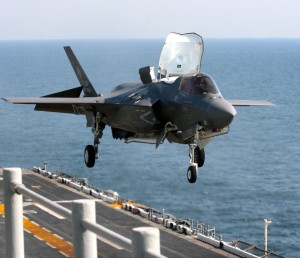
This capability establishes a new vector for TacAir aircraft design.
This can be measured on a “Z” axis.
What makes this possible is the F-35B has both a fully up air-to-air and air-to-ground capability. In the AA mode it is supersonic and stealthy with the same “Z-axis” revolutionary C4ISR-D cockpit that Navy F-35Cs and AF –F-35As both have. Consequently, the F-35B can fit seamlessly into the Air Force/Navy Air Dominance mission.
Historically, air fleet command and control, now C5ISR, was external to 1,2,3, and 4th Generations TacAir. C &C goals were to enhance fleet wide combat performance for all Type/Model/Series (T/M/S) of TacAir.
This is the modern AWACS , Hawkeye and Aegis battle concept.
Now using a three-dimensional graph the “Z-axis” research takes airpower into a totally different domain. The shift is from externally provided C&C to C5ISR-D in the cockpit carried by the individual air platform.
This is the revolutionary step function that breaks the linear progression of previous Generations.
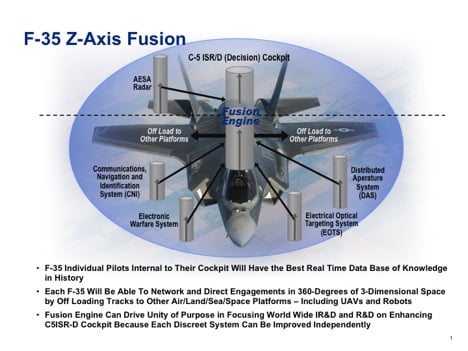
The “Z” axis is reflected in the emergence of the “C5ISR –D (for decision) cockpit”. This will be conjoined with a new helmet which can integrate with the cockpit. Currently there is still ongoing considerable research on getting the helmet correct-but this is the IR&D vector.
But wait it gets even better.
Since no platform fights alone: the entire F-35 Type/Model/Series connects the Air Force, Navy, Marines, and Allies in a cohesive unified fighting force.
This is why a combination of an F-35A with the B can provide a possible vector of RAF and RN synergy and convergence in shaping a combined approach.
Additional assets that can really augment this US and Allied “joint” air force is the Aegis Ships with the SM-3 missile and SSGN with cruise missiles for fire support .
No longer should the F-35B be considered a boutique niche aircraft only essential for Marine combat con-ops. With vision and commitment on numbers it can become a tactical aircraft that sends a strategic signal.
The reason is simple, an F-35B can stand strip alert on any long runway, U.S. or Allied. From a strategic point of view think of Guam, South Korea or in the Middle East on all long runways.
As a crisis situation develops, the F-35Bs can be remotely placed in secret hardened bunkers and revetments and thus become a significant deterrence asset that can instantly sortie into combat and return to gas and go again and again.
The F-35C, Navy version, is tied to large deck “cat and trap” angle decks, whereas the F-35B is a flexible tool able to deploy on many ships, working concurrently with helo and MV-22 flight ops and on many airfields, fixed, long, short, or not even todays operational airfields but just hard surface roads.
The F-35B reverses the relationship between pre-defined operational bases and the aircraft. The aircraft no longer constrains the definition of an airfield.
The sortie rate of an F-35 aircraft is more than just rearm and “gas and go.” It is continuity of operations with each aircraft linking in and out as they turn and burn without losing situational awareness.
This can all be done in locations that can come as a complete tactical surprise –the F-35B sortie rate action reaction cycle has an add dimension of unique and unexpected basing thus getting inside an opponent’s OODA (Observe, Orient, Decide and Act) loop…..


